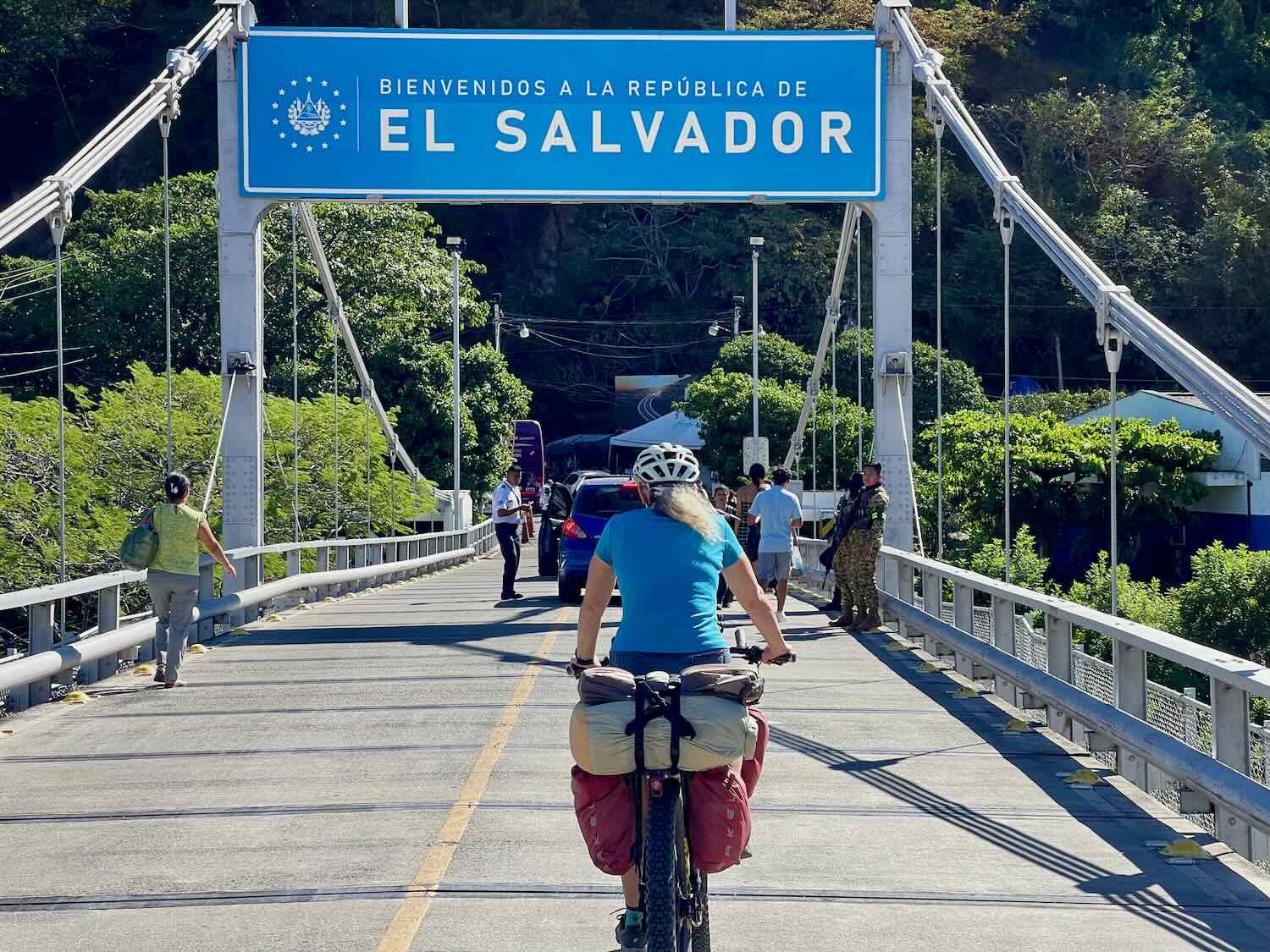Cycling across Guatemala and El Salvador
10 December 2023 - 8 January 2024
10-11 Dec - Guatemala City to Cuilapa, Guatemala (40.8 mi, 65.7 km)
12 Dec - Cuilapa to Jalpatagua, Guatemala (27.9 mi, 44.9 km)
13 Dec - Jalpatagua, Guatemala to Ahuachapán, El Salvador (25.2 mi, 40.6 km)
14-15 Dec - Rest days in Ahuachapán, El Salvador
16-17 Dec - Ahuachapán to Sonzacate, El Salvador (28.8 mi, 46.3 km)
18 Dec - Sonzacate to San Salvador, El Salvador (36.3 mi, 58.4 km)
19 Dec-3 Jan - Holidays in San Salvador, El Salvador
4-5 Jan - San Salvador to Cojutepeque, El Salvador (24.0 mi, 38.6 km)
6 Jan - Cojutepeque to El Triunfo, El Salvador (44.8 mi, 72.1 km)
7-8 Jan - El Triunfo to Santa Rosa de Lima, El Salvador (43.5 mi, 70.0 km)
Back on the PanAmerican Highway
By the time we left Guatemala City, we had already been in Guatemala for 48 days - more than half of the 90 days we were allowed on our CA-4 visa. That left us only 42 more days to cross the remainder of Guatemala, plus the other three countries covered by the CA-4 visa (El Salvador, Honduras, and Nicaragua). Fortunately, the terrain gradually becomes more mellow when traveling from the highlands of Guatemala to the flat coastal plain of Honduras and Nicaragua, so it would soon be possible to cycle a lot farther each day. By cycling on paved roads and keeping our layovers relatively short, we could still make it to Costa Rica before our CA-4 visas expired.
And so we found ourselves back on the PanAmerican Highway, with the hope of speeding up our cycling. But the key word in the paragraph above is that the terrain *gradually* becomes less arduous, because Guatemala City is still very much located in the Guatemalan Highlands. As we worked our way towards El Salvador, we would traverse three more long, steep ridges of mountains - each one a bit lower than the ridge that preceded it - in a stair-step descent out of the highlands.
Departure from Guatemala City
As the largest urban area in Central America, Guatemala City covers a huge region. For the first 2.5 hrs of cycling out of the city, we churned slowly uphill on a road that was lined with dense urban and commercial developments. We were lucky that it was Sunday, so the traffic wasn’t too bad while we exited the urban core. Along that stretch of highway the developments were fairly generic, and it felt like we could have been cycling through any city suburbs in the world.
A very big dog watched over the entrance to a pet supply store. This puppy stood about two stories tall. Guatemala City, Guatemala. Copyright © 2019-2024 Pedals and Puffins.
After cresting the ridge we enjoyed a glorious, 15 mile (24 km) descent that finally brought us into a more rural area, where we entered pineapple country. For a long stretch of road in the valley, we passed dozens of fruit stands selling pineapples, with a few bags of oranges thrown in. It’s actually pretty typical in Latin America to pass through areas where everyone is selling the same product from individual, small, roadside stands, one after another. Whether it’s corn, papayas, pottery, wood furniture, handmade toys, or (in this case) pineapples, we’ve wondered how 5-20 different vendors can make any money when they are all selling the same exact items so close to each other.
For many miles the side of the road was lined with fresh pineapples for sale (with the occasional, very large bag of oranges). El Cerinal, Dept of Santa Rosa, Guatemala. Copyright © 2019-2024 Pedals and Puffins.
With just a mile to go to our destination, we turned off the PanAmerican Highway towards the town of Cuilapa (pop. 49,000), passing under a flamboyantly decorated arch that was spruced up with giant red, paper flowers. And then, like so many other towns we had visited in Guatemala, we immediately began climbing a big hill that had us down in our lowest gear. But it wasn’t so bad, because our spirits were lifted by a line of palm trees down the center of the road median, each one decorated with a big, red flower. It was a very cheerful and festive arrival.
Heading under the beautiful welcome arch on the approach to the town of Cuilapa, Dept of Santa Rosa, Guatemala. Copyright © 2019-2024 Pedals and Puffins.
But Cuilapa threw us one more curve ball before we could call it a day. Our hotel was located at the top of a ridiculously steep, cobblestone driveway. After cycling more than 40 miles (65 km) through the mountains, it was more than we could tackle. We dismounted our bikes and slowly pushed them up that last, little bit of road, stopping every 10-15 meters to rest.
Descending the steep driveway from our hotel back to the main road. At the end of a long day of cycling we had to push our bikes up this driveway to reach the hotel. Cuilapa, Dept of Santa Rosa, Guatemala. Copyright © 2019-2024 Pedals and Puffins.
In the late afternoon we went out to explore town. There was an event going on in one of the town’s two, main plazas. And it seemed like everyone in the region had descended on the town to hang out at the festival or go shopping. Not far from our hotel, two busy roads crossed each other without the benefit of a traffic light or anyone directing traffic. It was total chaos, as cars, chicken buses, motorbikes and tuk-tuks jockeyed for position and tried to find a way through the maze. Many drivers expressed their displeasure by leaning heavily on their horns, adding to the cacophony of revving engines. Needless to say, crossing that intersection on foot was was an adventure. At least the traffic wasn’t moving very fast.
This intersection would have benefitted greatly from having a traffic light, or at least someone there to direct traffic. Cuilapa, Dept of Santa Rosa, Guatemala. Copyright © 2019-2024 Pedals and Puffins.
All afternoon we had been listening to very loud music drift up from the town below. Now we found the source. Near a centrally located plaza, a bandstand was set up with a spectacle under way. A live band blasted out pop tunes, in between passionate sermons by an evangelical preacher over a very loud sound system. In between the speeches, a troupe of girls in long, white dresses decorated with colorful scarves danced to the music waving flags, tambourines, and colored scarves. Lots of folks were seated in the temporary chairs set out for the audience, and the surrounding plaza was crowded with people. It was quite a show.
A troupe of dancers performed to music from a live band, between passionate mini-sermons from an evangelical preacher. Cuilapa, Dept of Santa Rosa, Guatemala. Copyright © 2019-2024 Pedals and Puffins.
The nearby plaza was beautifully decked-out for Christmas, with more of the big, red flowers on its palm trees, plus bright red banners and strings of lights. Cuilapa, Dept of Santa Rosa, Guatemala. Copyright © 2019-2024 Pedals and Puffins.
A large Nativity graced the front courtyard of the municipal building. Note that the baby Jesus is hidden under a cloth. By tradition, the figure of the baby is only placed in the Nativity (or in this case revealed from under the cloth) on Christmas Eve. Cuilapa, Dept of Santa Rosa, Guatemala. Copyright © 2019-2024 Pedals and Puffins.
The Geographic Center of the Americas
It wasn’t until we wandered across town to the city’s other plaza that we learned about Cuilapa’s main claim to fame. The park is christened the ‘Central Park of the Americas.’ And within it lies a map of the western hemisphere, complete with an arrow-shaped pendulum pointing at the approximate location of Cuilapa. In case you haven’t picked up on the significance of these hints, a sign proclaims that Cuilapa is the ‘Geographic Center of the Americas.’ We’ve not been able to discover how this calculation was made. And a quick online search indicates that several other towns (including one each in Belize, Honduras and Panama) also claim this distinction. But perhaps it doesn’t really matter, as long as it gives Cuilapa a sense of pride (and the opportunity to display an artful, geographic display in its plaza!).
An arrow-shaped pendulum points (roughly) to the spot of Cuilapa on the map. According to the town’s boosters, Cuilapa is the Geographic Center of the Americas (quite a distinction). Cuilapa, Dept of Santa Rosa, Guatemala. Copyright © 2019-2024 Pedals and Puffins.
We spent the next day in Cuilapa allowing our legs to adjust to being back on the bikes after the long break in Guatemala City. A visit to the town’s local history museum was the highlight of our day. The museum displays a small but well-preserved collection of artifacts from the Xinka culture, most of which were discovered on surrounding farms and donated by the landowners. Recognized as one of Guatemala’s official indigenous groups, the Xinka people had very deep roots in the southern part of the country. Its villages pre-dated the arrival of the Mayans, and their language is said to be unrelated to any other in the world.
A fountain in the courtyard of the Xinka Museum evokes the pottery of the area’s original inhabitants. Cuilapa, Dept of Santa Rosa, Guatemala. Copyright © 2019-2024 Pedals and Puffins.
Xinca indigenous artifacts, collected from the region surrounding the town of Cuilapa. Xinka Museum, Cuilapa, Dept of Santa Rosa, Guatemala. Copyright © 2019-2024 Pedals and Puffins.
Our favorite part of the museum was a collection of photographs from the region that were taken in the early 1900s. Some of the photos depicted places we had visited in Antigua and Guatemala City, and it was fascinating to see what they looked like in the past.
Perusing the historical photographs from early 20th century Guatemala. Xinka Museum, Cuilapa, Dept of Santa Rosa, Guatemala. Copyright © 2019-2024 Pedals and Puffins.
House geckos have been common in buildings along our route for quite a while now. They occasionally make a very loud, chirpy call which is hard to believe comes from such a small animal. Most hotels and houses seem to have a few resident geckos (hence the name), but people don’t mind. Geckos help out by preying on insects and spiders, and a lot of folks think having a gecko in the house is good luck. Some people even make pets out of them.
These two geckos, on a wall of the museum, were some of the bigger geckos we’ve seen. Xinka Museum, Cuilapa, Dept of Santa Rosa, Guatemala. Cuilapa, Dept of Santa Rosa, Guatemala. Copyright © 2019-2024 Pedals and Puffins.
The Festival of the Virgin of Guadalupe (12 December)
Legend says that in 1531 the Virgin Mary appeared to an indigenous farmer named Juan Diego on a hill near Mexico City, and spoke to him in his native tongue. She asked him to tell the bishop in Mexico City to build a church in her honor on the hill. Through a miracle, her image was imprinted on the inside of Juan Diego’s cloak. The miracle convinced the the bishop that this was indeed a divine request, and he helped to build the first church dedicated to the Virgin of Guadalupe. Nearly 500 years later, we visited the current Basilica of Our Lady of Guadalupe when we passed through Mexico City last summer.
Since her appearance in 1531, the Virgin of Guadalupe has become one of the most beloved figures in Catholicism, especially in Latin America. Her image, drawn from the one imprinted on Juan Diego’s cloak, is ubiquitous throughout Mexico and Central America. Guatemala has adopted her as its patron saint as well. So it’s no surprise that the celebration of her saint day, which falls on 12 December (the day the miraculous image of the virgin appeared in Juan Diego’s cloak) is a big deal in the country.
Around 4:00am on the morning on 12 December we awoke to the sound of explosions from celebratory fireworks and bombas (firecrackers that have a lot in common with a stick of dynamite, and sound like a cannon being fired). We lay in bed listening to the racket, which sounded remarkably like we were in the middle of battle zone. Any further sleep was elusive.
Fortunately, the day’s ride was not too long, but it felt longer because of the wind. We spent the day cycling on a very busy road, under a blazing-hot sun, with a strong headwind. Stopping to look at the scenery (which was rather ordinary) and taking photos just weren’t a priority.
The most noteworthy event along the route was an encounter with a fallen utility pole. It had toppled over into the roadway, taking multiple electrical and communication lines down with it. The pole completely blocked the traffic lane heading in the opposite direction. Plus, one of the wires had snapped free and flung itself completely across the roadway, so we had to ride over it (the wire was insulated, so it probably wasn’t as dangerous as it seemed). Although the busy road was now constricted to a single lane, there was no backup of traffic yet, so we guessed that the pole had fallen just before we arrived. Surprisingly, there was no sign of a traffic accident that could have knocked the pole over. It looked as if the pole had just fallen by itself - perhaps it had rotted at the bottom and the wind finally caused its demise. This theory was supported by the fact that further down the road we saw other utility poles that looked rotted at the base, and ready to topple over any minute.
This utility pole was lying across a full lane of traffic on a two-lane roadway, having brought down all the wires with it. The guy in the photo was wearing a uniform and inspecting the site. Traffic was not yet backed up, so the pole probably had fallen shortly before we got there. Oratorio, Dept of Santa Rosa, Guatemala. Copyright © 2019-2024 Pedals and Puffins.
About 2.5 hrs into the ride the wind really started whipping. It was blowing 15-20 mph, with gusts 25-35 mph (40-55 kph). Twenty minutes later PedalingGal got blown off the road. Her wheels went into the ditch and her bike fell to the left, knocking her into the traffic lane. She was fortunate that there weren’t any cars approaching, but it was scary nonetheless.
We arrived in the town of Jalpatagua (pop. 19,000) in the early afternoon, and were thrilled to be able to check into a hotel room right away. It was heaven to get out of the heat and wind. We had lost more than 3,000 ft in elevation (915 m) since leaving Guatemala City, and it was definitely getting warmer as we descended.
After a refreshing rest in our room, we headed out to explore town. As we approached the main plaza, we heard what sounded like a live band playing. We arrived just in time to see a procession celebrating the Virgin of Guadalupe. A wooden cart was being pushed down the street by a group of older women in native dress. The cart was adorned with flowers. An image of the Virgin - with her night-sky cloak and rays of light radiating in all directions - was placed high in the center. Towards the front was a statue of Juan Diego - complete with straw hat and a red, spotted scarf. The marching band followed along behind. We watched as the procession passed slowly by, heading towards the church.
Procession honoring the Virgin of Guadalupe, celebrating her saint day on 12 December. Jalpatagua, Dept of Jutiapa, Guatemala. Copyright © 2019-2024 Pedals and Puffins.
The plaza and surrounding streets were buzzing with activity. There was a line of food stalls and carnival rides for the kids. And most of the children were dressed up for the day. The tradition in Guatemala is for girls to wear indigenous outfits, and for boys to dress like Juan Diego (including having a beard drawn on their chins with black pencil). Parents even dressed up their toddlers and babies. It was fun to see everyone out having a good time.
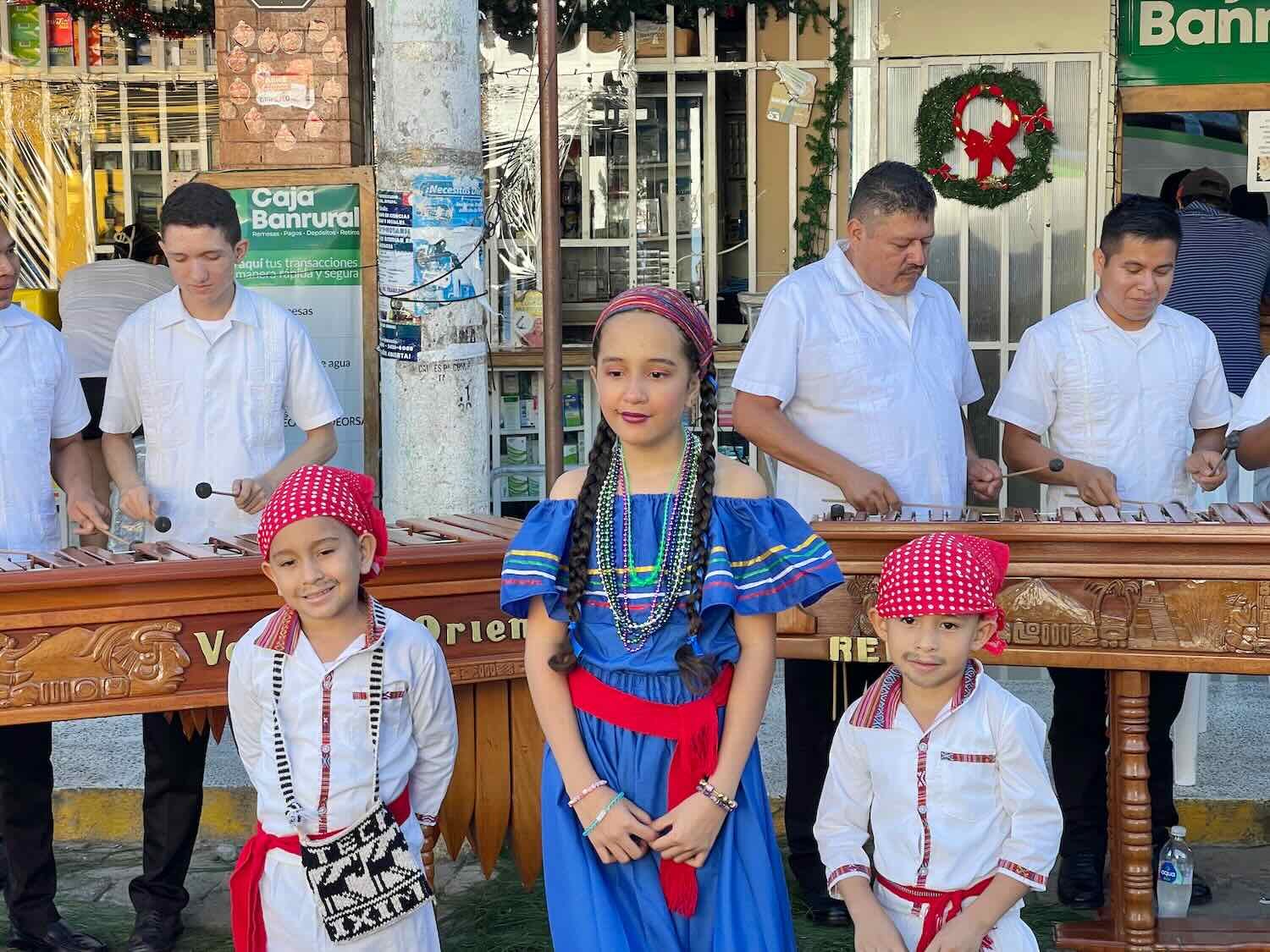
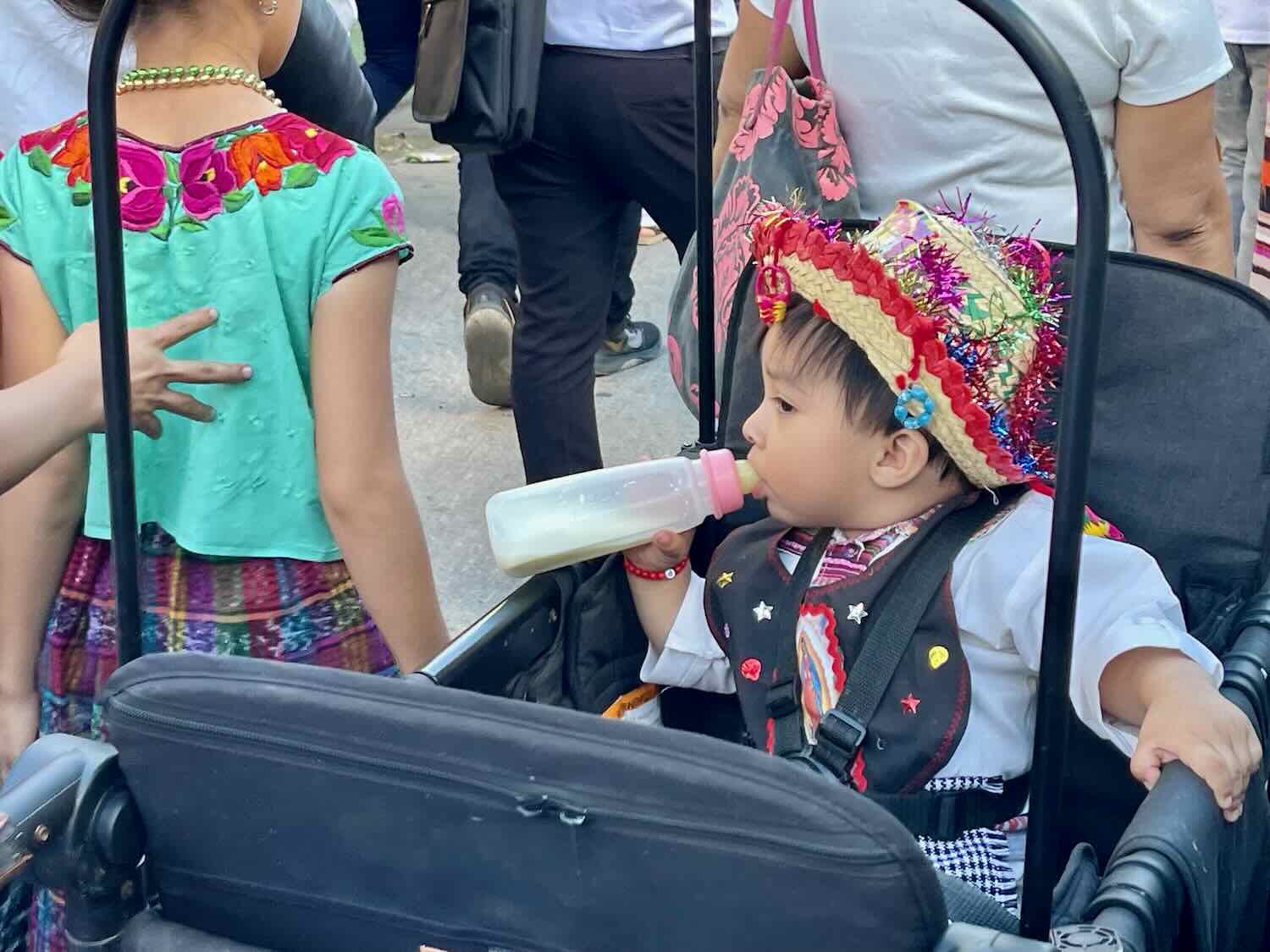
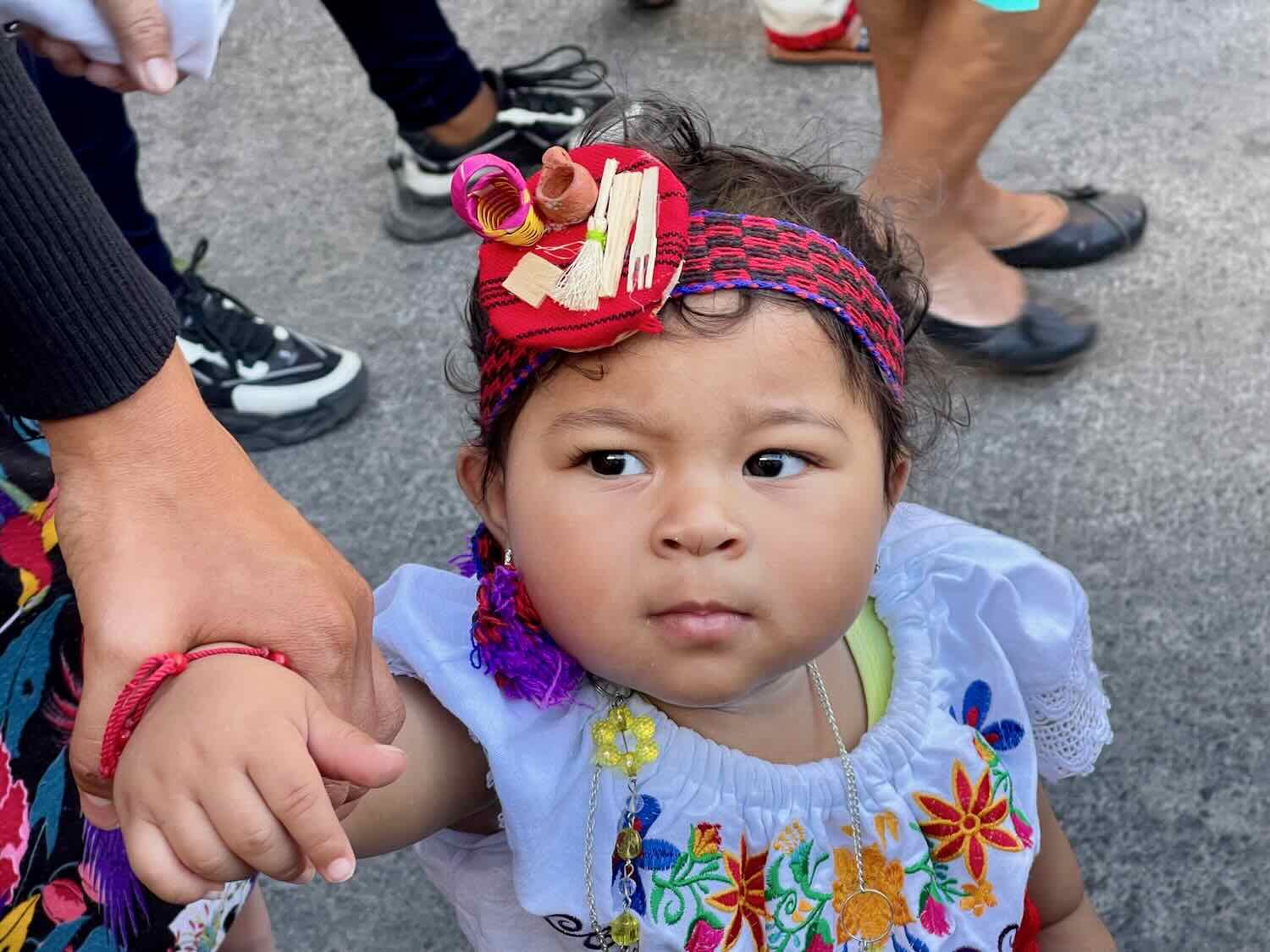
Before long we heard the band approaching again as the procession came back down the road. This time, the cart would stop every so often. Then, as the band played, the older women would parade in a circle around the cart, swishing their skirts in time to the music. A second, smaller image of the Virgin was placed in the road in front, where the younger girls (and a few young boys) danced in a circle around her. It was a serious occasion, but everyone was clearly enjoying themselves as well. It was a wonderful way to spend the afternoon.
Every so often the procession would stop, and the women and girls would parade around the images of the Virgin of Guadalupe, swishing their skirts in time to the music from the marching band. Jalpatagua, Dept of Jutiapa, Guatemala. Copyright © 2019-2024 Pedals and Puffins.
A marimba band serenaded the crowd along the side of the plaza. Jalpatagua, Dept of Jutiapa, Guatemala. Copyright © 2019-2024 Pedals and Puffins.
A Rough Day
The next morning got off to a rough start. We had only been on the road for about 15 minutes, when PedalingGal noticed that her click-stand was missing. (A click-stand is a foldable, aluminum pole that is used to prop up the bicycle while it’s parked. It’s very useful with bikes like ours that don’t have a good spot to attach a regular kick stand.) PedalingGal typically carried her click-stand in a pouch on the outside of one of her stem bags, but it was gone.
It was possible that it had fallen out of the pouch when she had laid her bike down, just outside the hotel that morning. So we raced back to the hotel, hoping to find the click-stand there.
But when we reached the hotel, it was nowhere to be found. In hindsight, it probably fell out of the pouch when her bike toppled over into the road the day before, because of the strong wind. There was no way to know for sure. The only thing that was certain was that the click-stand was gone. It was a bummer, because getting a new click-stand would not be easy. They’re manufactured by a one-man company in the USA, and are only available via online orders. To replace her click-stand, we’d have to figure out how to get a new one shipped to us somewhere down the road - never an easy task in Latin America.
After a couple of hours of cycling in more heavy winds, we finally arrived at the border between Guatemala and El Salvador. The approach to the border was complete pandemonium. A huge line of cars jostled with trucks and buses across multiple lanes of approach, stretching for at least half a mile. As we weaved our way among the vehicles, money-changers approached us, waving handfuls of cash and asking if we needed to change some money.
We did have Guatemalan quetzals that we needed to change to US dollars (the official currency of El Salvador). But when we stopped to talk with one of the money-changers, two other guys came over and started to talk over each other, creating a confusing situation. That’s when we should have become suspicious and walked away. But we didn’t. We tried to get the two other guys to go away, walking our bikes over to the side of the road with the first guy. But each time the other two guys backed off, they would soon return and keep talking - repeating stuff we said or just blustering. Oddly, the guy we were trying to change money with did not shoo them away (which should have been another red flag). But the distraction caused by these guys made it hard to concentrate on the details of the transaction, which was probably their motive.
As a result, we lost our focus. After the money changed hands, PedalingGuy immediately counted the dollars, and realized within moments that the money changer had short changed us. But he had already disappeared - poof! We tried to find him among the crush of vehicles and pedestrians, but he was gone. PedalingGal ran over to the other two guys, who had moved on to another potential mark in a car. But when she asked them where the money changer was, they played dumb. We were out of luck. We have changed money many times with informal money changers at borders and elsewhere, in a large number of countries, and this was the first bad situation we had ever encountered. PedalingGuy was furious at himself for letting it happen, and it cast a dark cloud over the rest of our day.
Out of sorts, we then tried to work our way through immigration. The signage was confusing, and people were milling about all over the place. We got in a long line for pedestrians that wound around a corner outside of the building, unsure if that was where we should go. Finally, a Good Samaritan that was in line behind us helped to get clarification that we were, in fact, in the correct line.
It took a while, but we finally made it into the immigration building. It was packed with people in multiple lines leading to six processing windows. PedalingGuy waited outside to guard the bikes while PedalingGal stood in line inside. When she finally reached the front of the line, PedalingGuy was able to come inside for just a few moments to get his exit stamp. We were thrilled that the exit process, in the end, turned out to be quite simple.
Upon leaving the building we followed some people and got into another line. We stood in that line for about 10 minutes before realizing that we seemed to be heading back into Guatemala. A quick conversation with another border guard confirmed that we were in the wrong line. He pointed us down the road, in the direction of El Salvador.
Still feeling glum abut the money, and annoyed at the chaotic situation, we trudged down a very busy road that was crowded with vending stalls and throngs of shoppers. Then the crowd melted away as we crossed a bridge into El Salvador.
Crossing the Río Paz, between Guatemala and El Salvador. Valle Nuevo, Guatemala. Copyright © 2019-2024 Pedals and Puffins.
Arrival in El Salvador
On the far side of the bridge an official checked our passports. When he saw that we were foreigners, he helpfully walked us over to the correct immigration office to enter the country. Unlike the departure from Guatemala, the foreign immigration office for El Salvador was a modern, tranquil space with absolutely nobody in line. Where did everyone go? There must have been a different office for handling citizens of Guatemala and El Salvador (both CA-4 visa countries), because the crush of people was gone.
Within just a few minutes we were stamped into El Salvador. Much to our surprise, our entry stamp said that we could spend 180 days in El Salvador. That was very generous. But the truth was that the 180 day allowance for El Salvador would not be honored by the other CA-4 countries (i.e., Honduras, Nicaragua and Guatemala). It only applied to our stay in El Salvador. The other countries would continue to only allow a total of 90 days, beginning with our original arrival date in Guatemala. This is definitely not intuitive, and some travelers have been slapped with hefty fines for overstaying the CA-4 visa, because they thought an extended stay they received in one country would be valid throughout the zone. It is not.
This begs the question of what exactly the CA-4 ‘tourist visa’ accomplishes. The system is not at all like the European Schengen zone, where the internal, national borders are almost invisible. Quite the contrary - border crossings for foreigners within the CA-4 zone are as complicated and time-consuming as border crossings can get. Perhaps the CA-4 agreement between the countries is genuinely useful to the citizens of those countries, who can move around the region, visa-free. But for foreign tourists, the internal CA-4 border crossings are baffling because they all have different rules. Several (but not all) of the countries require payment of entry and exit fees, as well as cumbersome processing procedures. Honduras even takes your photo and prints of all eight fingers and two thumbs at the border. And the fact that the individual countries, like El Salvador, can have their own visa time allowances that are separate from the CA-4 system just seems like a recipe for confusion.
As a result, regardless of what our El Salvador entry stamp said, we still had less than 40 days to get all the way across the remaining CA-4 countries that lay along our route.
The Colors of Ahuachapán
After crossing the border we found ourselves on a nice, wide, paved shoulder - heaven for a couple of cyclists. In fact, the condition of the roads throughout El Salvador was a step up from the narrow, winding, steep highways of Guatemala. It was still fairly mountainous, but at a much more manageable level.
A hot, windy, uphill ride finally brought us to Ahuachapán (pop. 34,100), the first big town in El Salvador. We ended up spending two days there, enjoying the high energy of a bustling frontier community while deciding on our route across the country. A highlight of our stay included daily visits to the very chaotic and colorful town market.
No matter which day of the week or what time of day, the town market - which occupied many city blocks - was busy with folks out shopping. Ahuachapán municipal market, Dept of Ahuachapán, El Salvador. Copyright © 2019-2024 Pedals and Puffins.
Tropical fruits for sale in the market. Ahuachapán municipal market, Dept of Ahuachapán, El Salvador. Copyright © 2019-2024 Pedals and Puffins.
One of our favorite snacks was a juicy slice of fresh pineapple, usually packaged in a plastic sandwich bag and sold in the market or on a street corner. Ahuachapán municipal market, Dept of Ahuachapán, El Salvador. Copyright © 2019-2024 Pedals and Puffins.
Few live animals are sold in these markets, but chickens are the exception. There are often a few ladies clustered together, cradling a live chicken or two for sale. Ahuachapán, Dept of Ahuachapán municipal market, El Salvador. Copyright © 2019-2024 Pedals and Puffins.
It was also possible to buy chicken and turkey chicks to start your own flock. Ahuachapán municipal market, Dept of Ahuachapán, El Salvador. Copyright © 2019-2024 Pedals and Puffins.
What does a watch vendor do when he needs to broaden his inventory? Make a trade with another one of the numerous vendors selling watches of dubious quality. Many years ago PedalingGuy bought a watch in a street market from a guy much like these, and it stopped keeping time in less than 24 hours. Ahuachapán, Dept of Ahuachapán, El Salvador. Copyright © 2019-2024 Pedals and Puffins.
This vendor used every available means to carry her wares, looking for customers among the shoppers in the market. Ahuachapán municipal market, Dept of Ahuachapán, El Salvador. Copyright © 2019-2024 Pedals and Puffins.
Vendors typically pack up all of their unsold goods and take them away every night. So each morning, several hours are spent laying everything out on the tables again. It seems like a lot of work, but an advantage is that they pay little (if any) rent, especially compared to vendors that occupy brick and mortar stores. Ahuachapán municipal market, Dept of Ahuachapán, El Salvador. Copyright © 2019-2024 Pedals and Puffins.
Salvadoran cabbage slaw in vinegar, called ‘curtido’, is a very popular side dish - often served with street food. This vendor was pre-shredding cabbage, onion and carrots to make home preparation of curtido easier. Ahuachapán municipal market, Dept of Ahuachapán, El Salvador. Copyright © 2019-2024 Pedals and Puffins.
An appealing display of produce. Ahuachapán municipal market, Dept of Ahuachapán, El Salvador. Copyright © 2019-2024 Pedals and Puffins.
In Central America, you’re rarely far from the ocean, so fresh seafood is readily available in every market. Ahuachapán municipal market, Dept of Ahuachapán, El Salvador. Copyright © 2019-2024 Pedals and Puffins.
Hopefully the next customer won’t want one of the pots that’s buried in the middle of this pile. Ahuachapán municipal market, Dept of Ahuachapán, El Salvador. Copyright © 2019-2024 Pedals and Puffins.
To a northerner, the sight of a pile of sharp machetes sitting out on a table in the market is a bit disconcerting. But they are an indispensable tool in the tropics, and it’s common to see men, and even young teens, carrying the big blades while walking down the road. There are many types of machetes, designed for specific uses. This vendor is selling billhook machetes (curved blades for cutting brush) and cane knives (specifically designed to harvest sugar cane or corn). Ahuachapán municipal market, Dept of Ahuachapán, El Salvador. Copyright © 2019-2024 Pedals and Puffins.
With Christmas only 10 days away, a whole section of the market was devoted to holiday decorations. Ahuachapán municipal market, Dept of Ahuachapán, El Salvador. Copyright © 2019-2024 Pedals and Puffins.
There are always a few vendors selling inexpensive toys, especially with Christmas approaching. Ahuachapán municipal market, Dept of Ahuachapán, El Salvador. Copyright © 2019-2024 Pedals and Puffins.
Unsold clothing inventory or quality second hand garments from the USA and Canada are delivered to markets in bulk, where shoppers can snag a bargain if they’re willing to sift through the piles to find something they like. Ahuachapán municipal market, Dept of Ahuachapán, El Salvador. Copyright © 2019-2024 Pedals and Puffins.
Beans are a huge part of the cuisine throughout Mexico and Central America. And for people who grow their own beans, or have small, family-owned farms, hand-sorting the beans is a regular activity. We’ve seen both men and women spend hours sorting beans at roadside shops, in their homes, and in markets like this one. Ahuachapán municipal market, Dept of Ahuachapán, El Salvador. Copyright © 2019-2024 Pedals and Puffins.
This vendor must have worn himself out sorting all those beans. Ahuachapán municipal market, Dept of Ahuachapán, El Salvador. Copyright © 2019-2024 Pedals and Puffins.
The town also had an attractive central plaza, shaded by tall royal palms and other big trees. In the middle stood a picturesque, multi-story gazebo with a clock tower on top. The Salvadorians didn’t go quite as crazy with Christmas decorations as the Guatemalans, but there were still some fun touches - like fabric snowmen - scattered throughout the park.
The lovely main plaza, with its pink limestone gazebo and abundance of big shade trees. Ahuachapán, Dept of Ahuachapán, El Salvador. Copyright © 2019-2024 Pedals and Puffins.
Hanging out with Mr. Snowman in the town plaza. Ahuachapán, Dept of Ahuachapán, El Salvador. Copyright © 2019-2024 Pedals and Puffins.
A whimsical doorway to a shop in town. Ahuachapán, Dept of Ahuachapán, El Salvador. Copyright © 2019-2024 Pedals and Puffins.
Route of the Flowers
Not that long ago El Salvador was one of the most dangerous countries in the world, with the highest homicide rate of any country as recently as 2015. Since then, a new government has implemented a massive crackdown on criminals and gangs, reducing the homicide rate a whopping 97%, from a high of 103 homicides per 100,000 people to less than 3 per 100,000 people in just eight years. It is now considered to be one of the safest countries in the world.
As a result, El Salvador which was once a no-go for tourists, is starting to see an influx of new visitors. Between 2022 and 2023 there was a 30% increase in the number of people arriving in El Salvador as tourists. In response, the country is laying the groundwork to showcase its natural and cultural treasures. But it is still very much off the beaten path. In many areas, you might not encounter any other foreigners. And even in some places that are considered tourist attractions, you are likely to feel that you are the only visitor.
That’s what it was like when we departed Ahuachapán to cycle the length of the Ruta de las Flores (‘route of the flowers’), a scenic drive that is a popular day trip for people from the capital city, San Salvador.
The route heads southward, across a low spot in the Sierra Madre mountains, between two national parks. So, of course, the first 11.5 miles (18.5 km) were all uphill. Luckily there was very little traffic, and a nice, wide, paved road margin. We stopped at regular intervals to rest, and even spotted a few of the area’s colorful birds.
Taking a break on the side of the quiet roadway. Ruta de las Flores, Dept of Ahuachapán, El Salvador. Copyright © 2019-2024 Pedals and Puffins.
A handsome turquoise-browed motmot, El Salvador’s national bird. Ruta de las Flores, Dept of Ahuachapán, El Salvador. Copyright © 2019-2024 Pedals and Puffins.
Seeing these gorgeous white-throated magpie-jays never gets old. Ruta de las Flores, Dept of Ahuachapán, El Salvador. Copyright © 2019-2024 Pedals and Puffins.
In the higher elevations, the slopes were covered with coffee plantations. Apparently the best time to visit the Ruta de las Flores is when the coffee plants are in bloom, blanketing the hillsides with white flowers. Our timing was not right for that. Most of the plants were already heavy with ripening coffee beans, which have their own, red beauty up close - but which don’t look particularly spectacular from a distance. Even so, there were quite a few other cultivated flowers blooming along the way.
Coffee beans ripening in the mountain sun. Ruta de las Flores, Dept of Ahuachapán, El Salvador. Copyright © 2019-2024 Pedals and Puffins.
As if heralding the imminent arrival of Christmas, there were many large poinsettia bushes in full bloom along the road. Ruta de las Flores, Dept of Ahuachapán, El Salvador. Copyright © 2019-2024 Pedals and Puffins.
The pansy-like flowers of Brazilian raintrees added a splash of purple along the way. Ruta de las Flores, Dept of Ahuachapán, El Salvador. Copyright © 2019-2024 Pedals and Puffins.
Brazilian red-cloak was a particularly popular planting along the sides of the road. Ruta de las Flores, Dept of Ahuachapán, El Salvador. Copyright © 2019-2024 Pedals and Puffins.
Ceiba trees are sacred in Mayan culture, for their role as a connector between the underworld, the earthly world, and the heavens. This 350 year old ceiba tree occupies its own plaza in a mountain town, presiding over a landscape that has been completely transformed during its lifetime. Salcoatitán, Ruta de las Flores, Dept of Ahuachapán, El Salvador. Copyright © 2019-2024 Pedals and Puffins.
After cresting the summit of the great ridge, we had a really long downhill ride. The slope was sufficient to propel us along at about 20 mph (32 kph), but not so steep that we had to use our brakes very much. It was a real treat not to have to worry about our brakes overheating, or to have to squeeze the brakes until our knuckles were white - like most of the downhills in Guatemala. We enjoyed the smooth sailing. Along the descent, towns became bigger and more frequent.
Several of the towns along the descent into Sonsonate were major producers of wooden furniture. Numerous small, family-run workshops lined the road, with their products lined up in rows out front. Ruta de las Flores, Dept of Ahuachapán, El Salvador. Copyright © 2019-2024 Pedals and Puffins.
Before long we rolled into the small city of Sonsonate (pop. 65,100), and ran into a huge traffic jam. There wasn’t an accident blocking the road. It wasn’t even a holiday (like the traffic jam we encountered on our way into a Guatemalan city on All Souls Day). This congestion seemed to be caused entirely by the fact that the only highway over the mountain simply disgorged all of its traffic onto a narrow city street, and there wasn’t enough room for everyone. Plus, there was a distinct lack of traffic lights, so every intersection was snarled with cars. We were fortunate that there was enough room for us to squeeze by all the cars. It’s times like this when we are especially happy to be traveling by bicycle.
The Murals of Sonsonate
We ended up spending an extra day in Sonsonate, an important business center in western El Salvador. Our morning walk took us through the older part of town, to the central plaza. Everything about the town had a scruffy, lived-in feel. It definitely was not spruced up for a tourist audience. But here and there we saw splashes of color. And there were several fun murals depicting local scenes. The art felt much less self-consciously ‘cultural’ than the murals we’ve seen in towns that attract more tourists.
Bold, bright colors on a home in Sonsonate. Dept of Sonsonate, El Salvador. Copyright © 2019-2024 Pedals and Puffins.
The welcoming smile of a coconut vendor - an appropriate image for an important commercial center. Sonsonate, Dept of Sonsonate, El Salvador. Copyright © 2019-2024 Pedals and Puffins.
This mural turned a solid wall into a delightful image of domestic tranquility. Sonsonate, Dept of Sonsonate, El Salvador. Copyright © 2019-2024 Pedals and Puffins.
With Christmas just a week away, holiday decorations were everywhere. It's remarkable how similar the decorations are all across the continent. Sonsonate, Dept of Sonsonate, El Salvador. Copyright © 2019-2024 Pedals and Puffins.
A New Volcano and a Whole Lot of Sugar Cane
As we rode out of Sonsonate in the early morning light, an impressive volcano rose up to the north. It had almost no vegetation, suggesting lava had flowed down its sides in the recent past. In fact, it is a relatively new volcano that emerged on the flank of another, older volcano in 1770. For the next 190 years it erupted almost continuously, and became known as the ‘lighthouse of the pacific.’ Like many volcanos, it has a tragic history. A particularly big eruption in 1926 wiped out a nearby town, killing 56 people. The volcano has been quiet since 1966, but its bare, rocky slopes are a reminder of its young age.
The picturesque Izalco Volcano provided a stunning view to our north as we cycled towards San Salvador. Izalco, Dept of Sonsonate, El Salvador. Copyright © 2019-2024 Pedals and Puffins.
Sugar’s dominant role in El Salvador’s economy was evident as we cycled from Sonsonate toward the capital city of San Salvador. Mile after mile of the highway was lined with sugar cane fields that stretched out across the landscape. The growing season for sugar cane in El Salvador is long enough that most farms produce two crops per year. As a result, some of the fields were still green and growing, while others were being harvested.
Before the harvest, sugar cane fields are traditionally burned to remove the leaves, kill or displace pests like snakes and scorpions (a danger to the field workers) and leave only the dried, sugar-filled stalks. While there are now modern techniques that can be used to harvest the green plants (which reduces harmful smoke and water pollution), most growers in El Salvador still burn their fields and harvest the crop by hand. In the areas where we saw workers in the fields, the sugar cane stands were brown and leafless. Under the baking sun, it looked like hot, difficult work as the sugar cane was cut by hand with machetes.
The tasseled flowers of sugar cane waved gently against the clear blue sky. Izalco, Dept of Sonsonate, El Salvador. Copyright © 2019-2024 Pedals and Puffins.
Agricultural workers were dwarfed by the tall, brown stalks of sugar cane as they hand-cut the crop with machetes. It looked like hot, hard labor. Cantón El Sunna, Dept of Sonsonate, El Salvador. Copyright © 2019-2024 Pedals and Puffins.
About four hours into the ride we stopped for an extended break at a convenience store in the town of Lourdes. The big draw for us was that the shop had air conditioning, plus a couple of tables with chairs inside. With the temperature pushing past 95F (35C), the cool oasis was just what we needed.
On hot days, we often snack on potato chips during our rides as a way to help replenish electrolytes. But since entering El Salvador, potato chips have become quite scarce. Instead, we’re seeing more banana chips, plus some other tropical snacks like cassava chips. (Cassava, a.k.a., manioc or tapioca, is a root crop that is a major source of carbohydrates in the tropics.)
A bag of salty, sour cream and onion cassava chips works almost as well as potato chips to replenish salt lost on a hot day. Unfortunately, although cassava is rich in several vitamins, it has less potassium than potatoes. Still, it makes a delicious, salty, roadside snack. Lourdes, Dept of La Libertad, El Salvador. Copyright © 2019-2024 Pedals and Puffins.
The break was just what we needed to help get us up the next, big hill. Right after leaving Lourdes, the hardest part of the day began, with a climb of 1,500 ft (460 m), on a very busy highway, during the hottest part of the day. As we slowly pedaled upwards the gradient was relentless, while the black exhaust from the passing vehicles choked us.
Adding to our troubles, the nice wide road shoulder we had enjoyed earlier in the day became intermittent, so there were some sections where there was almost no shoulder to ride on as the traffic roared by. The shoulder was particularly likely to disappear on the many bridges over small streams and gullies. It was a good thing that there were three lanes of traffic heading in our direction, so the cars, trucks and buses could swing wide and give us some room. Most, but not all of them did that. As usual, the big, intercity busses were the worst.
When we reached a longer bridge we were thrilled to see that it actually had a pedestrian walkway. So, of course, we rolled our bikes onto the catwalk. That turned out to be a bad idea. About halfway across, the walkway was literally falling apart. The concrete had collapsed, and the railing bowed wildly out to the side. It looked like if you touched the railing (let alone grabbed it for support), it would just fall off. The whole situation felt quite precarious, but by that point it was almost impossible to back up. We both jumped across a small section of the bridge that looked like it would not hold our weight. But the bikes had to be rolled across. So we said a little prayer, and hoped the floor would not give way, sending one or both of us down into the ravine below. Fortunately, we survived the crossing.
Negotiating a dicey river crossing on a collapsing pedestrian catwalk, bordering a busy, six-lane highway. Luckily, we survived. Colón, Dept of La Libertad, El Salvador. Copyright © 2019-2024 Pedals and Puffins.
The treacherous river crossing wasn’t the only obstacle we had to worry about. Even when there was a shoulder on the road, there would occasionally be gaping holes in the pavement that were ready to chew up a bike tire if we weren’t careful. San Salvador, El Salvador. Copyright © 2019-2024 Pedals and Puffins.
It was a huge relief when we finally reached the top of the big hill, and entered the suburbs of San Salvador. The traffic was still heavy, but at least it was moving a lot more slowly. Anything was better than what we had experienced cycling up that hill.
An evocative mural painted on the concrete support for a highway overpass. Approaching San Salvador, El Salvador. Copyright © 2019-2024 Pedals and Puffins.
After a day of cycling that felt much longer than it really was, we finally settled in to a modest hotel room in San Salvador.
Checking Out the Sights in San Salvador
From the start we had planned to spend a full week in San Salvador. A big driver was our desire to relax during the Christmas holiday. As a cosmopolitan city and the capital of El Salvador, San Salvador gave us the chance to connect with local Christmas traditions without having to worry about whether at least a few stores and restaurants would be open.
As mentioned above, not long ago El Salvador had the highest murder rate in the world. San Salvador was particularly crime ridden, with people afraid to leave their homes. But over the past eight years, the homicide rate has plummeted and other crimes (especially extortion) have also declined in tandem with a fierce crackdown on El Salvador’s notorious criminal gangs. As a result, the once-dangerous capital has become a safe place both for its residents, and for visitors to explore. During the first few days of our stay, we enjoyed going out on long walks each morning to check out different areas of this interesting city.
Situated near a prominent intersection of two major roads, this building stands out among the modernist structures that dominate the city. Originally the home of a wealthy coffee baron, the Venturoso Castle (a replica of a Scottish castle) is now a bank office. San Salvador, El Salvador. Copyright © 2019-2024 Pedals and Puffins.
One of the most famous monuments in the city is the Monument to the Savior of the World. While its name obviously alludes to the image of Christ atop the globe, it’s also a play on the name of the country (‘El Salvador del Mundo’) - a country that welcomes everyone from all over the world. San Salvador, El Salvador. Copyright © 2019-2024 Pedals and Puffins.
Seasonal decorations provided a splash of color to the small park surrounding the Monument to the Savior of the World. San Salvador, El Salvador. Copyright © 2019-2024 Pedals and Puffins.
It seemed like every little park and green space had been decorated for Christmas. San Salvador, El Salvador. Copyright © 2019-2024 Pedals and Puffins.
The Basilica of the Sacred Heart of Jesus is often cited as the most beautiful church in El Salvador. At a little over a century in age, its neo-gothic arches and spires still looked sharp and new. The solemn, somewhat plain interior contrasted markedly with the ornate carvings on the facade. And the large, circular, stained-glass window over the main entrance virtually glowed in the dim light of the central hall.

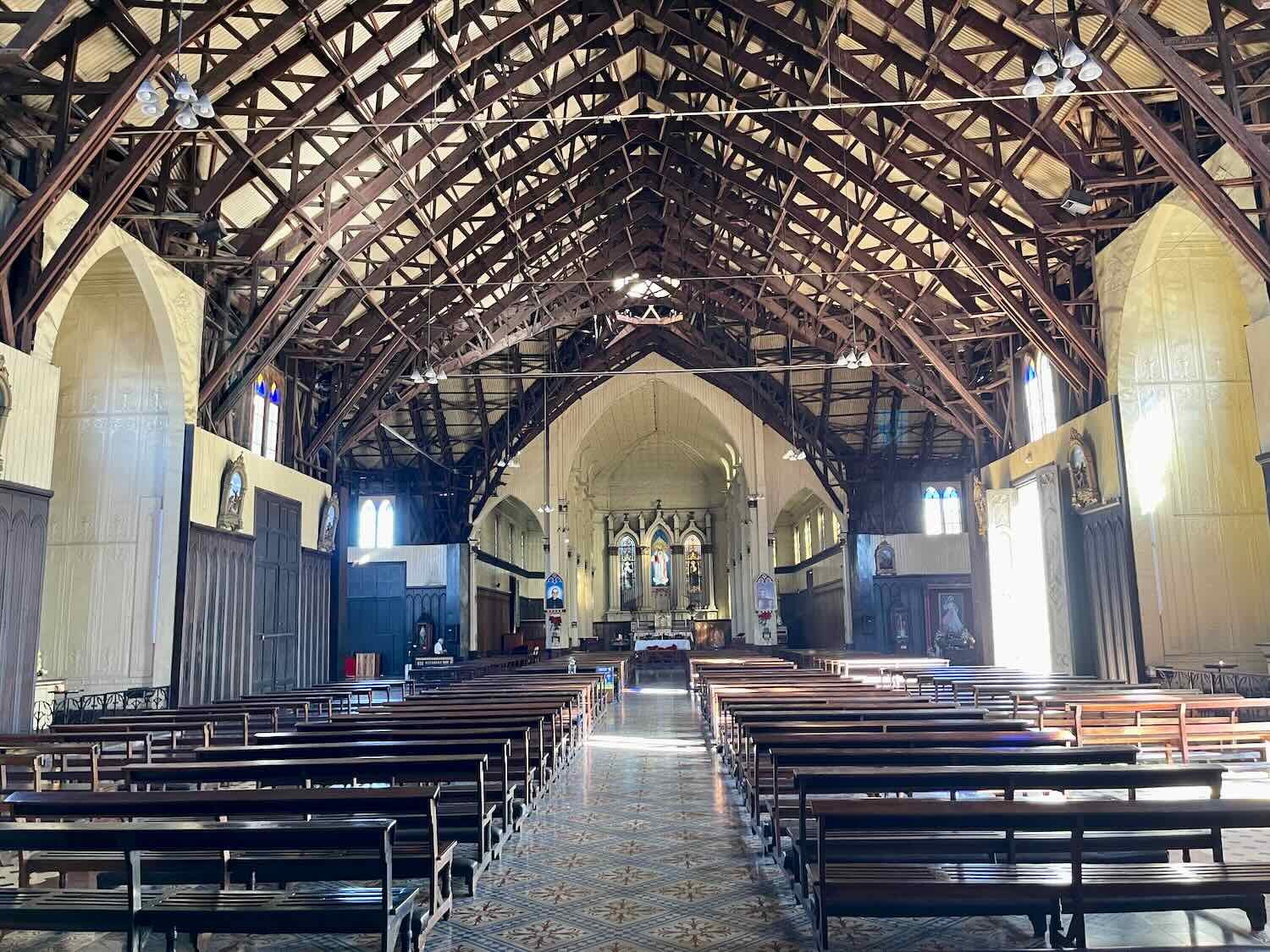
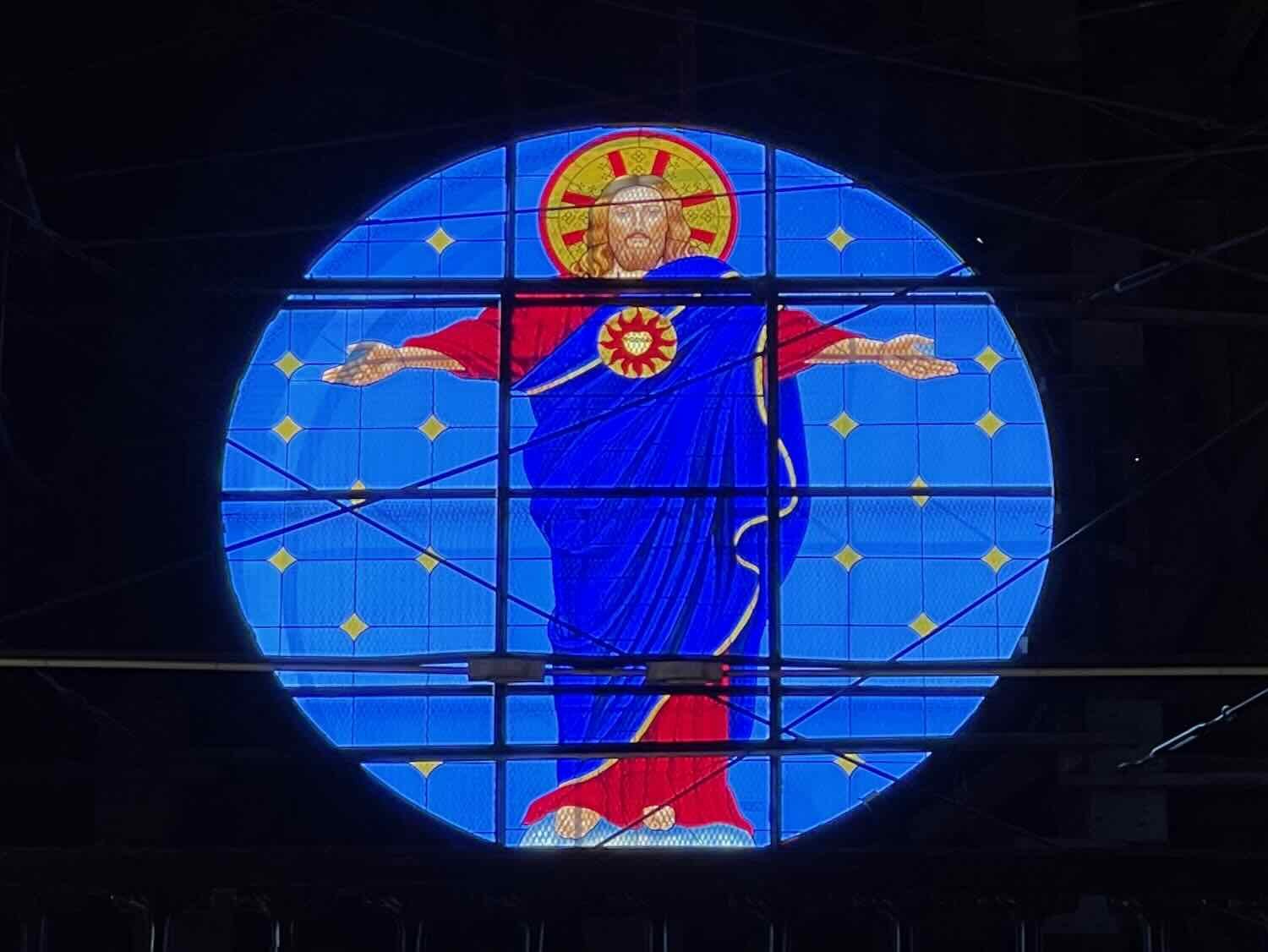
On the other hand, the famous Church of the Rosary was completely different from any other church we’d ever visited. Its plain, concrete exterior does not give any clues as to the stunning interior. But each tier in the church’s arched roof is lined with intensely-colored stained glass. And once inside, you feel like you’ve stepped into a rainbow. The dim lighting allows the rays of color from the windows to cascade across the interior space unimpeded.
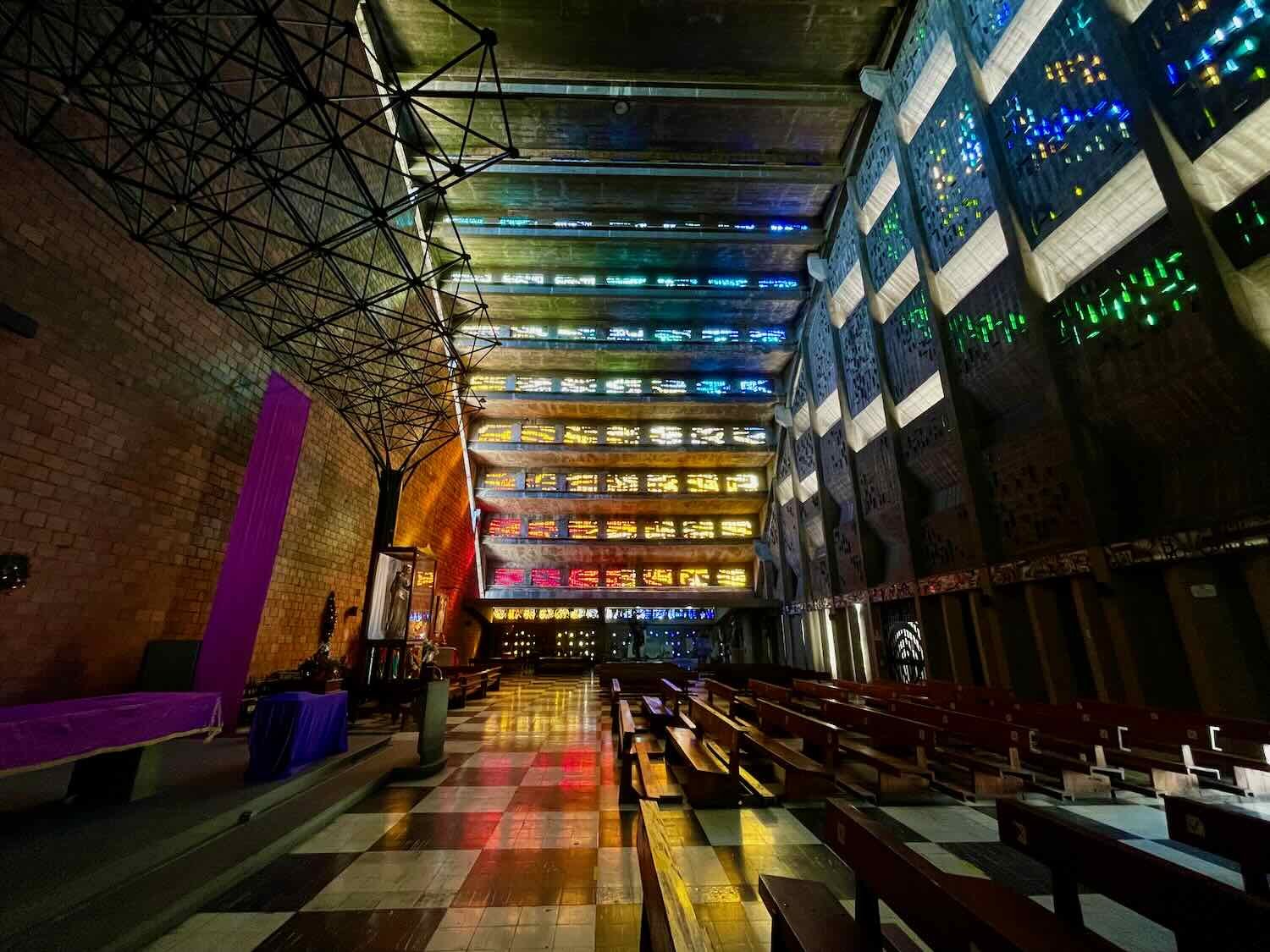
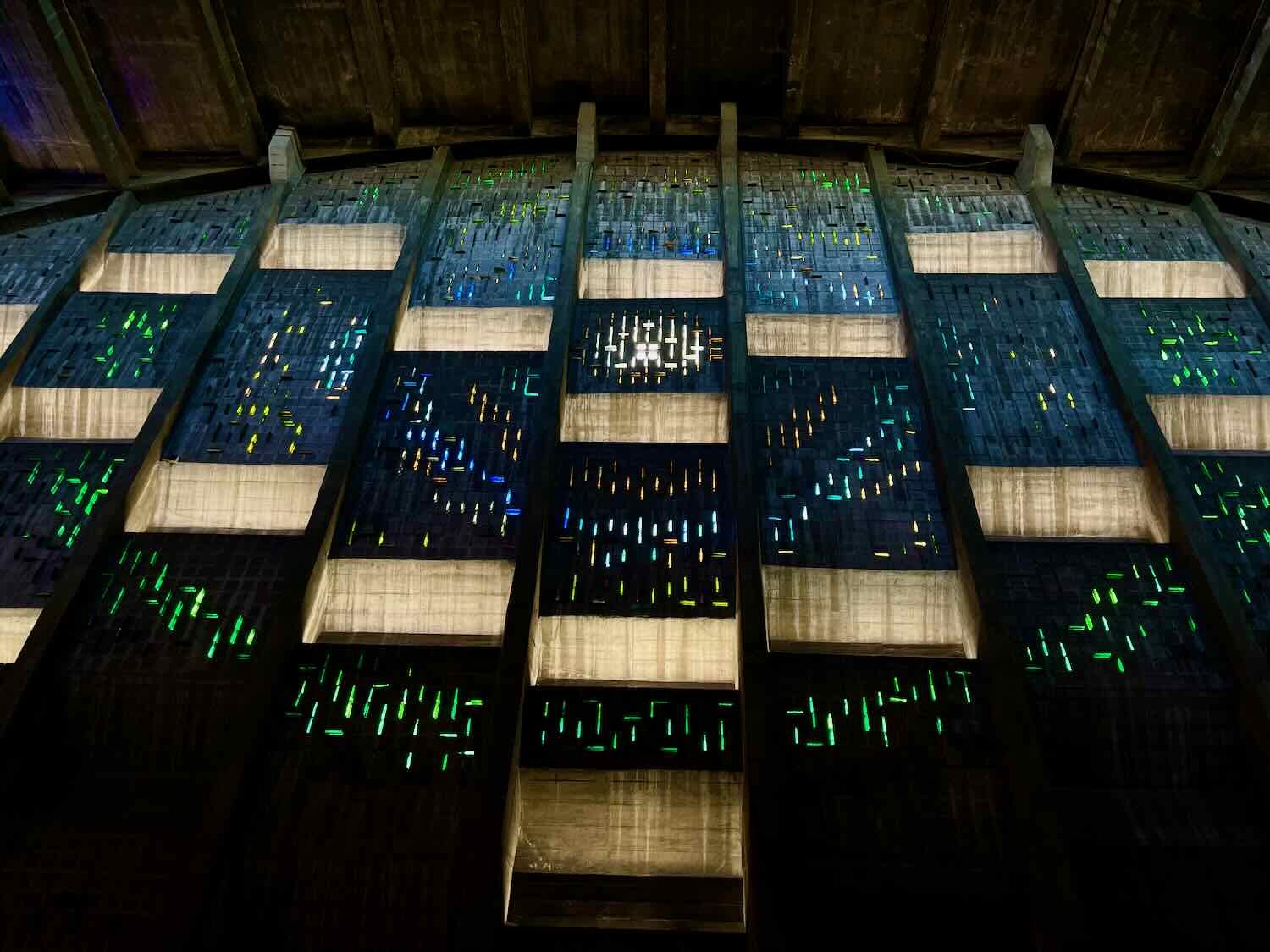
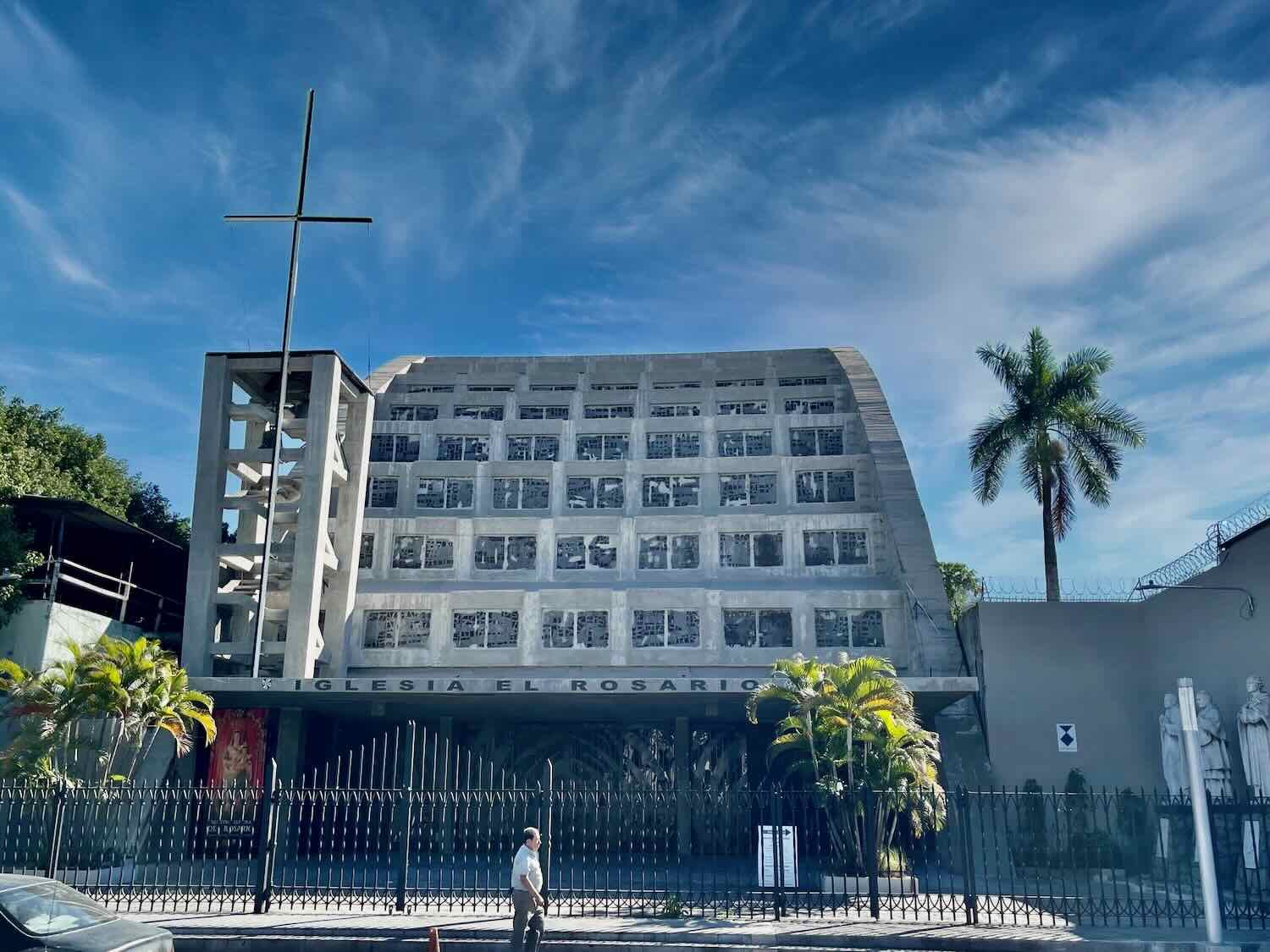
San Salvador’s central plaza is not laid out as a garden. Instead, it is a huge, flagstoned space that is better suited for massive gatherings (like the crowd that recently came to hear a speech by the newly re-elected President) than the family outings that are common in more park-like plazas. In this way it is reminiscent of the central plaza in Mexico City. One side of the plaza is dominated by the huge, grand National Palace. While this building served as the government’s headquarters until 1974, it’s no longer in use. These days visitors can go inside with tour groups to see the ornate salons. On each side of the Romanesque entry stand statues donated by the King of Spain - one of Christopher Columbus, and the other of his patron, Queen Isabella.
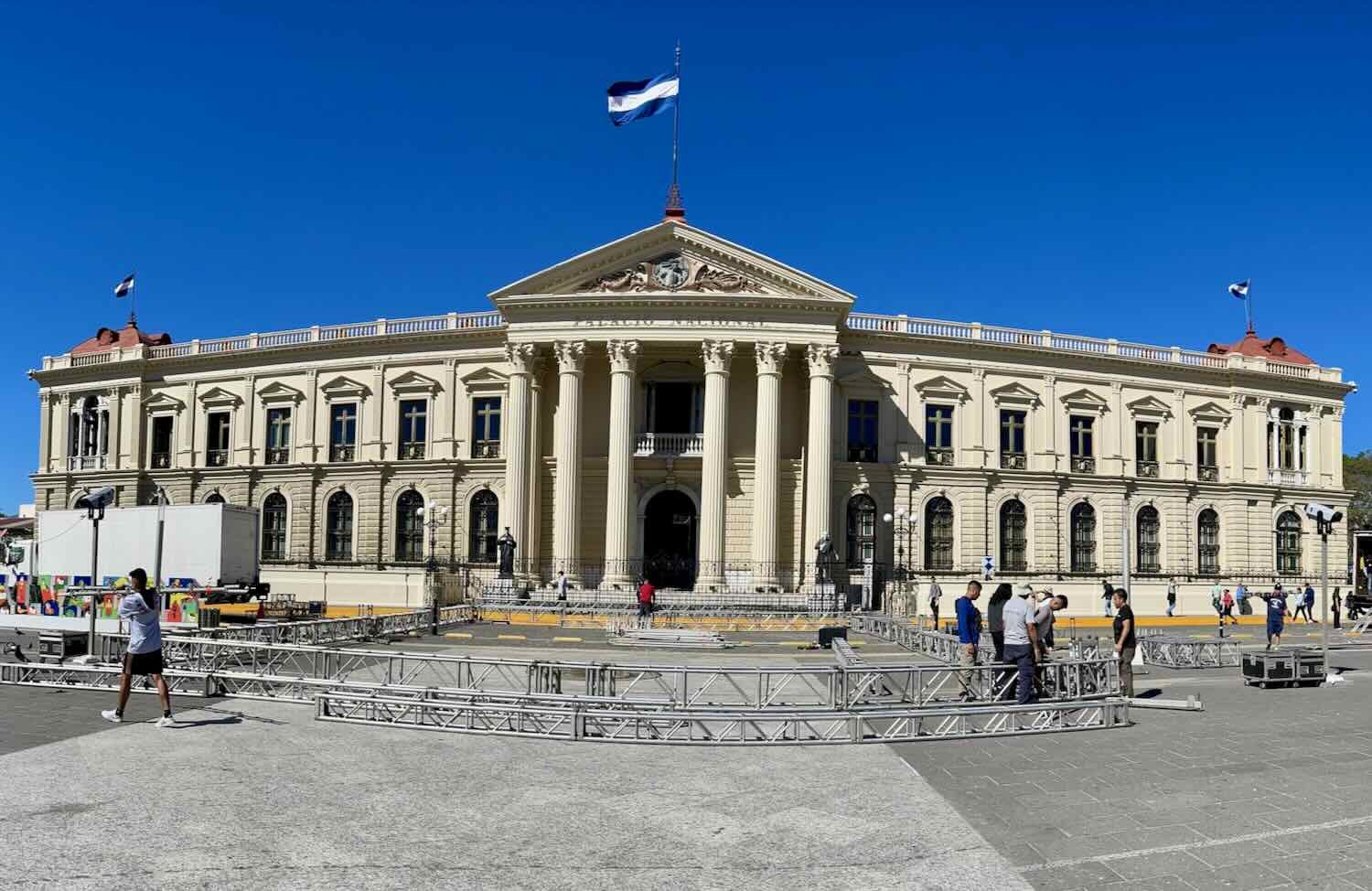
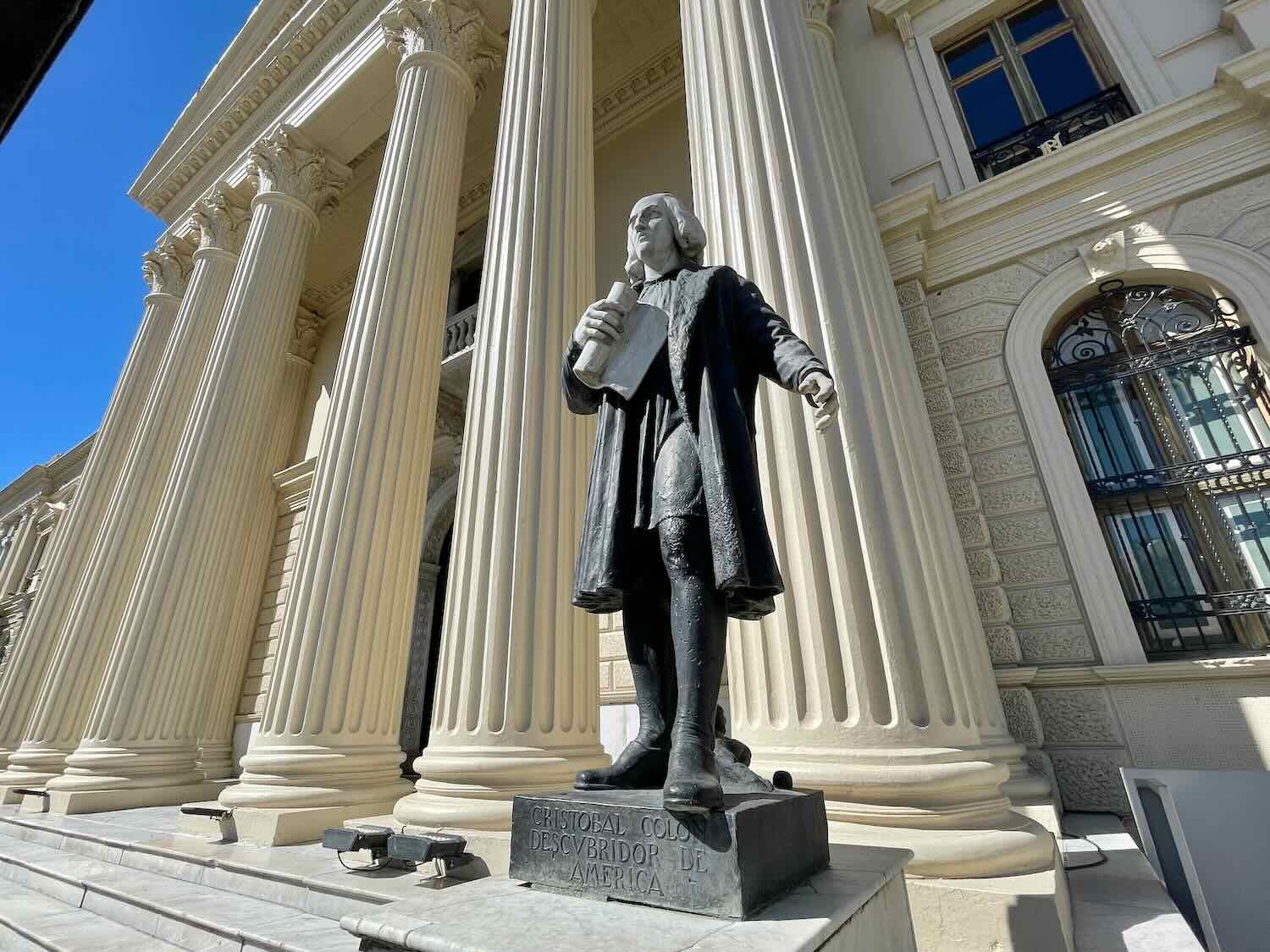
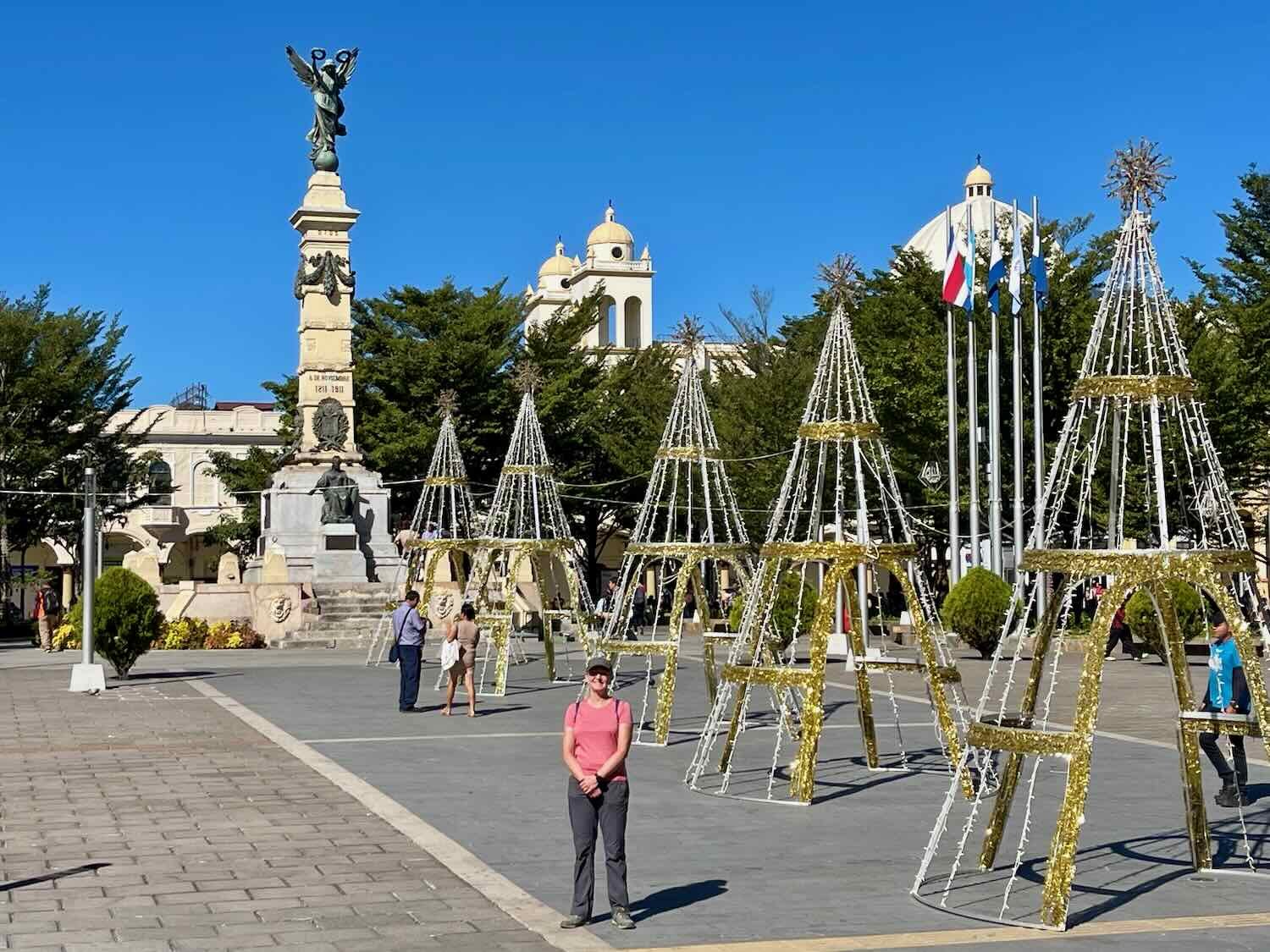
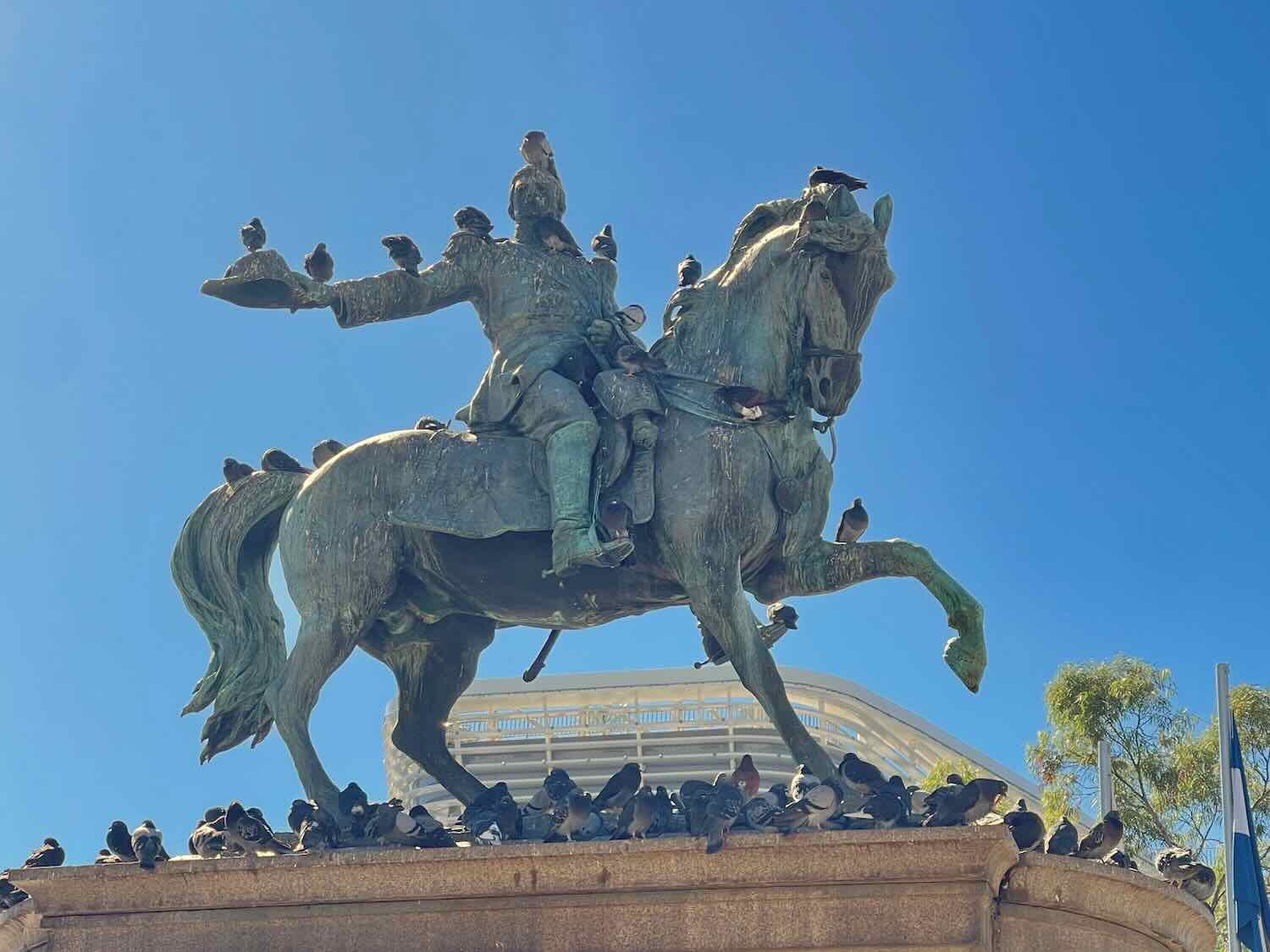
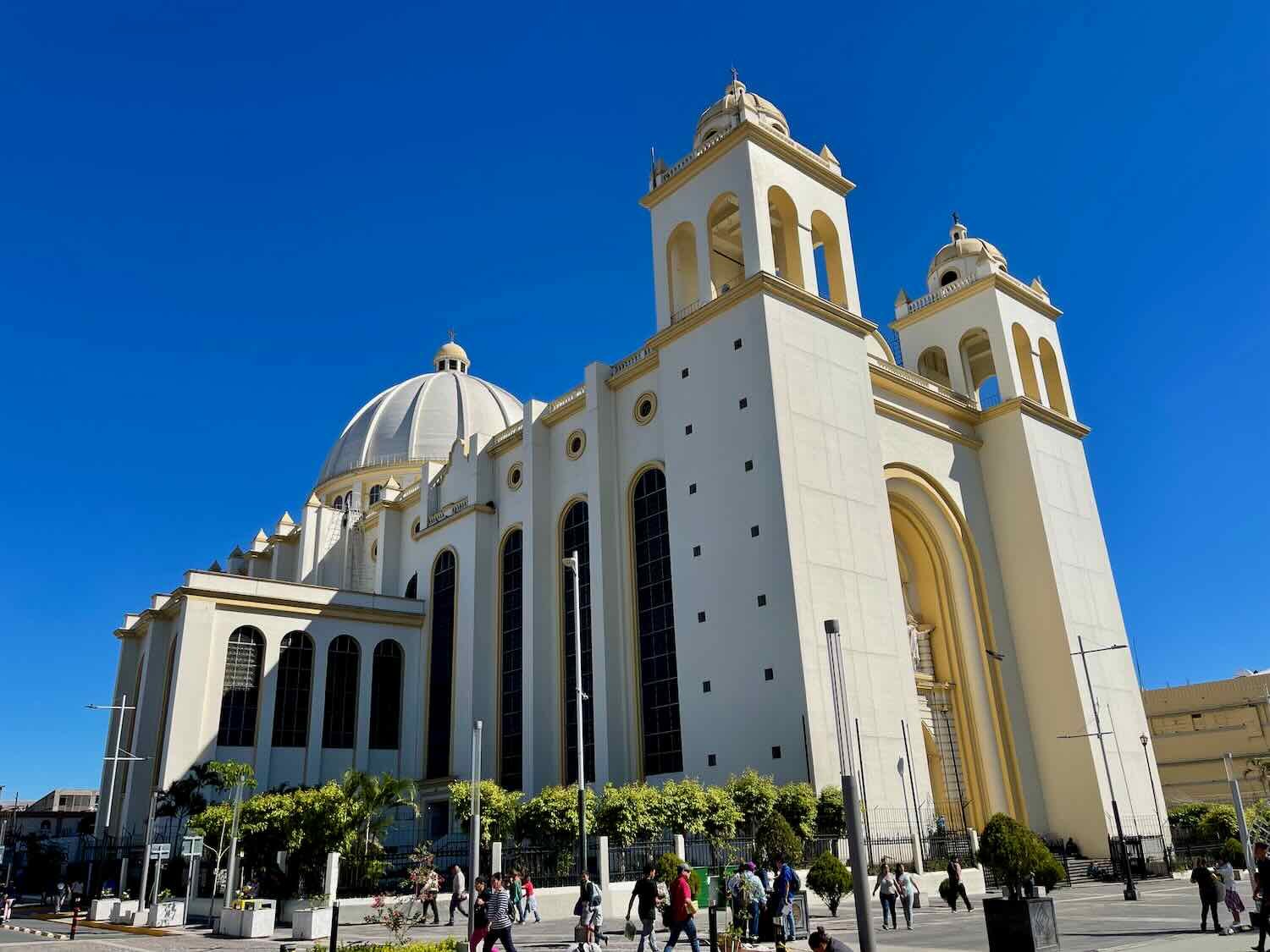
A massive, gorgeous mural decorates one side of the National Museum of Anthropology. San Salvador, El Salvador. Copyright © 2019-2024 Pedals and Puffins.
A large mall near our hotel was also decked in red and green, to get shoppers into the Christmas spirit. San Salvador, El Salvador. Copyright © 2019-2024 Pedals and Puffins.
A worker in an on-demand ice cream shop used liquid nitrogen to ‘instantly’ prepare a customer’s custom dessert. San Salvador, El Salvador. Copyright © 2019-2024 Pedals and Puffins.
We especially enjoyed a morning walk out to the city’s Botanical Garden. In addition to the leafy foot paths and interesting plants, there was quite a lot of wildlife taking advantage of this green oasis in the city.
Long fronds of a tropical plant created a green tunnel along a trail in the Plan de La Laguna Botanical Garden. San Salvador, El Salvador. Copyright © 2019-2024 Pedals and Puffins.
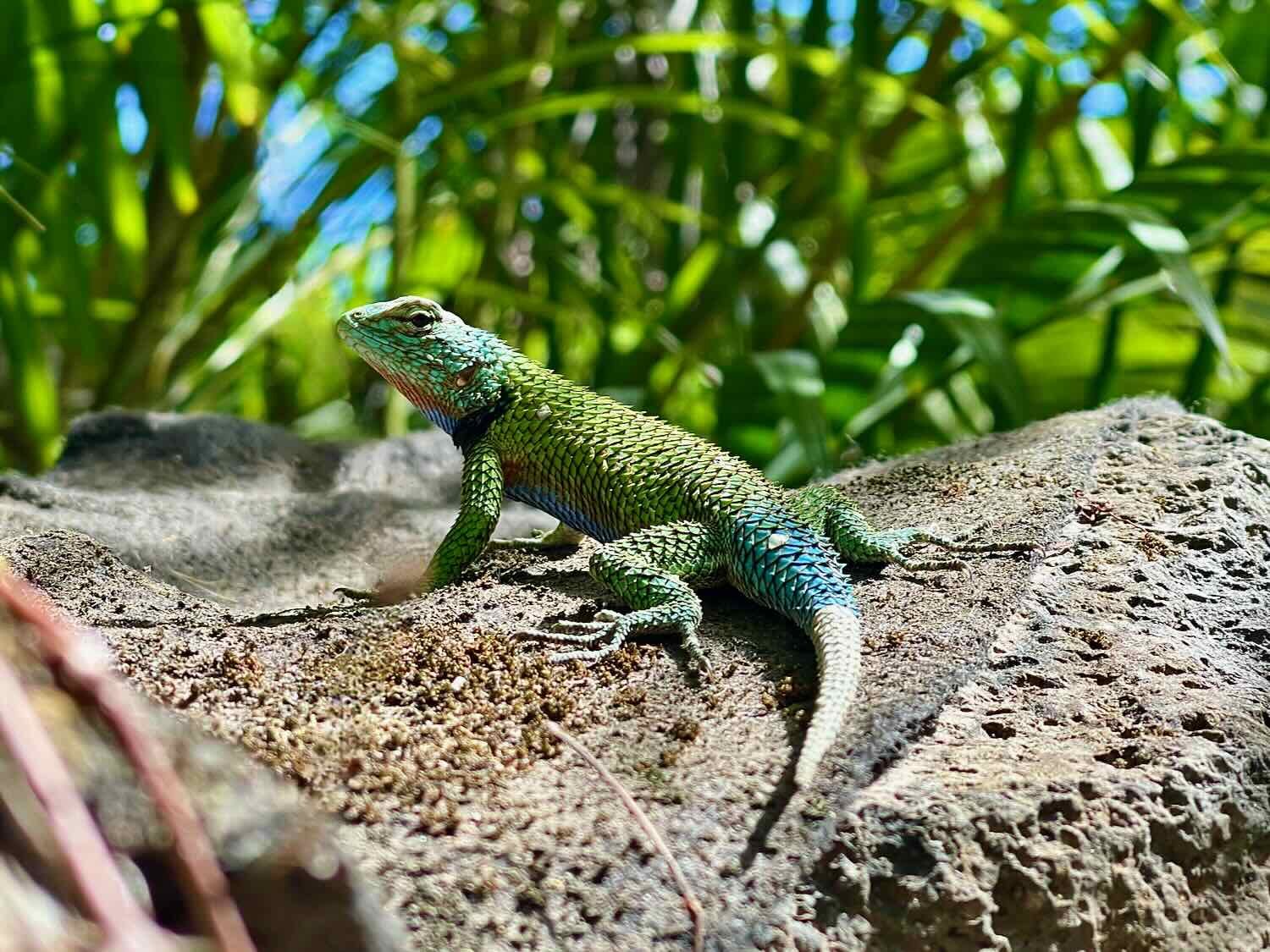
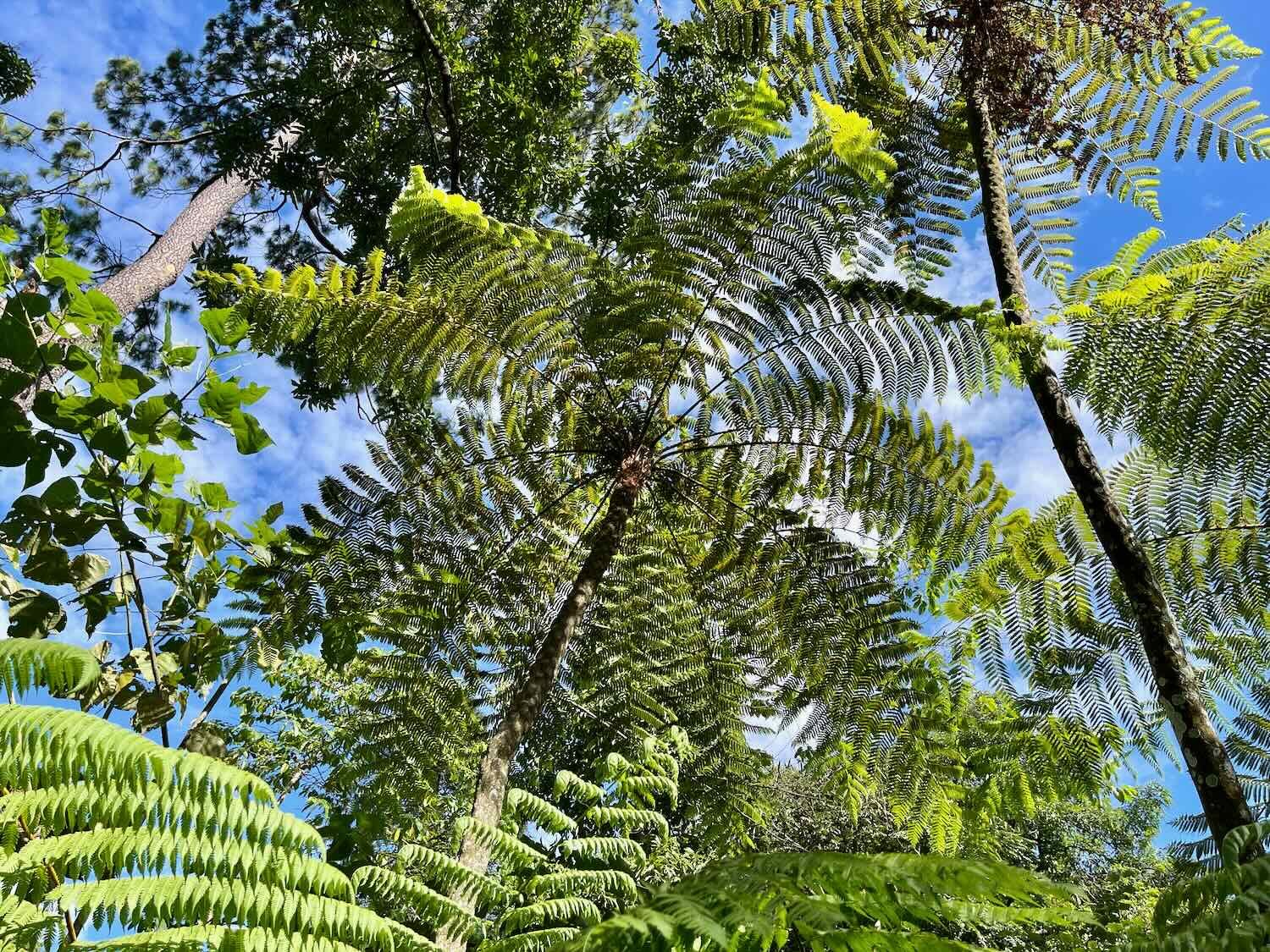
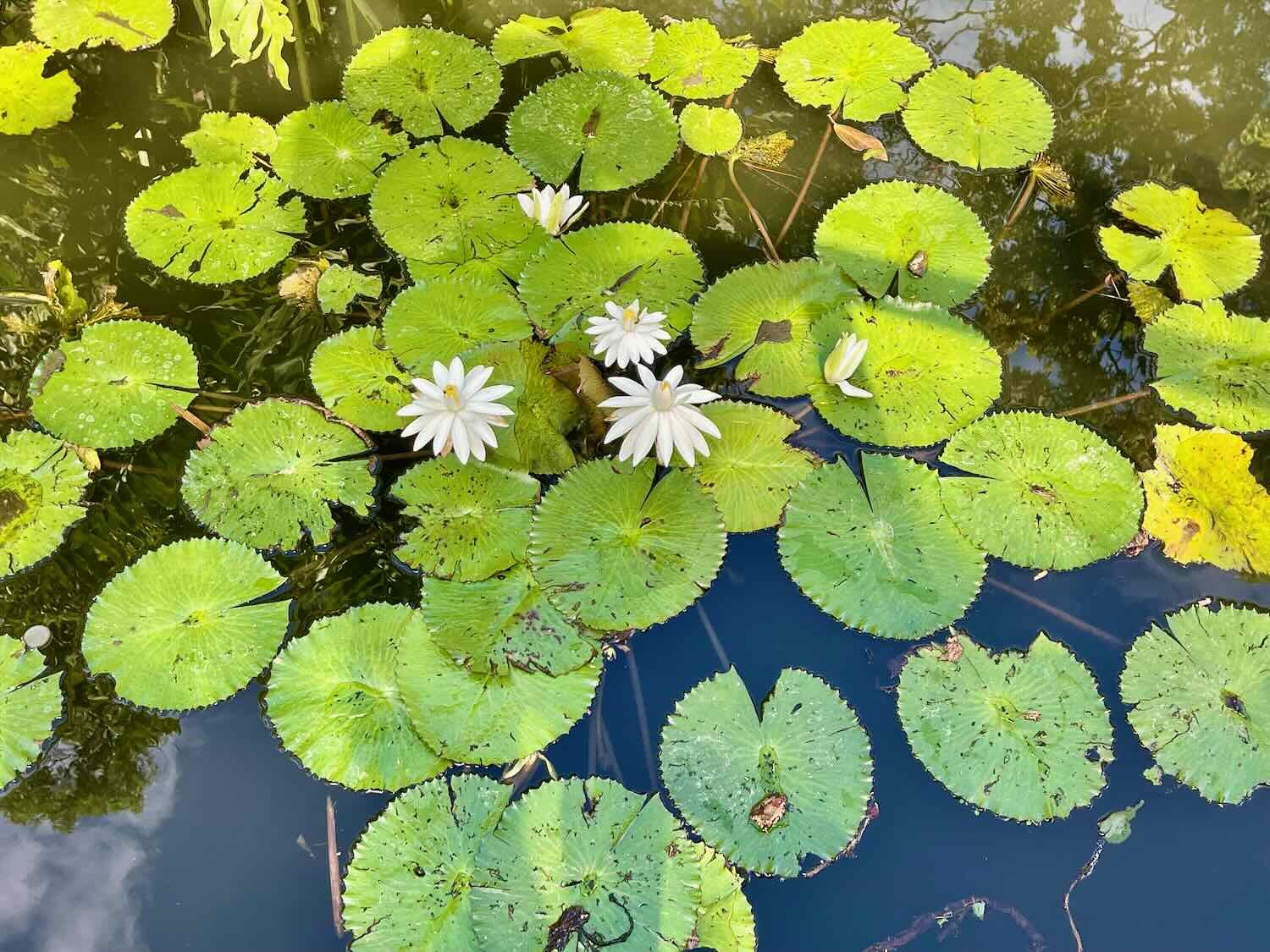
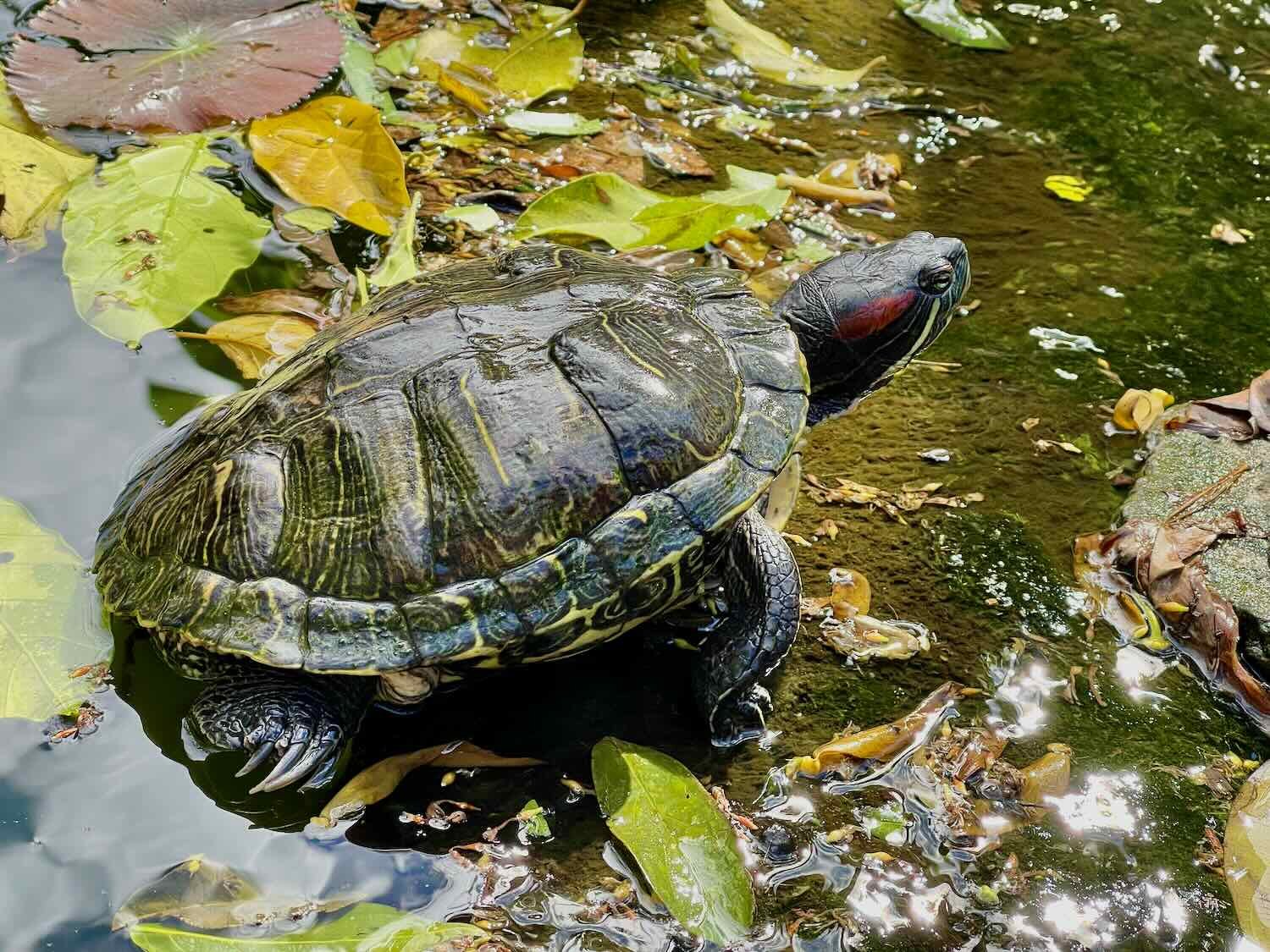
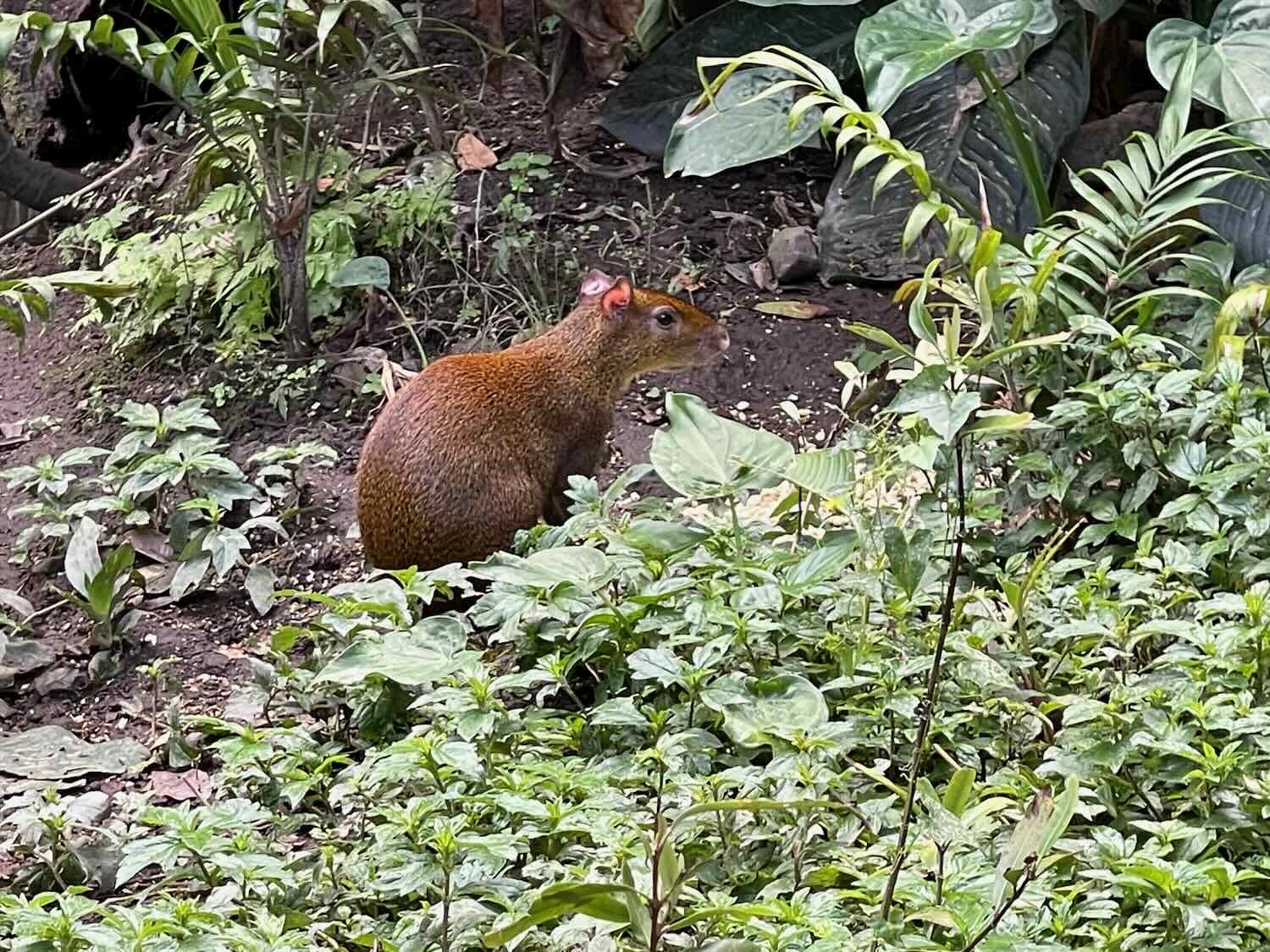
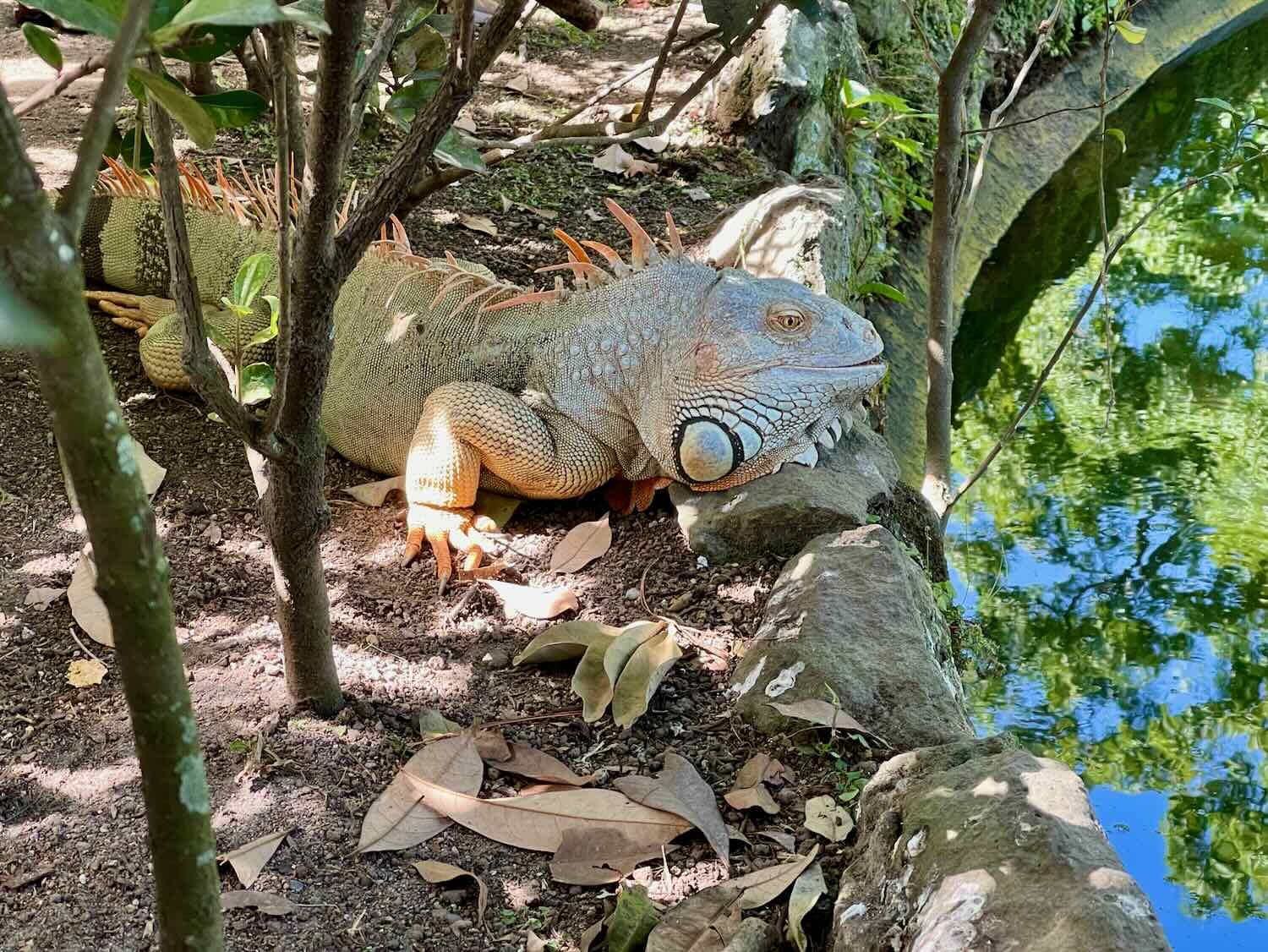
A Kink in Our Plans
Everything was going great until the night of December 23, right before Christmas Eve. That’s when PedalingGuy announced that he thought he was coming down with a cold.
The next day it was clear that this was not just any cold. PedalingGuy spent Christmas Eve and Christmas Day feeling horrible, with a fever, aches and pains, and awful sinus congestion. Four days later, while he was still feeling pretty ill, PedalingGal succumbed as well.
We ended up spending 16 days in San Salvador, mostly holed up in our hotel room, recovering. As luck would have it, we had booked a room with a kitchenette. That made it easy for us to prepare meals and eat comfortably in our room, so we didn’t have to eat out in restaurants. Although we didn’t have the chance to get out and celebrate Christmas or New Year’s Eve, we were grateful to be in a comfortable place where we could focus on our health.
A gorgeous sunset, seen from our hotel. San Salvador, El Salvador. Copyright © 2019-2024 Pedals and Puffins.
Getting Back On Our Bikes
After more than two weeks of minimal movement, we weren’t exactly in prime cycling condition when we set out from San Salvador. Our muscles had completely forgotten that we were on a long-distance bike trip. Plus, we both still had lingering sinus congestion and malaise from our illness. The best we could do was to get out on the road by 8:30am. Not the most inspiring start for a day of urban cycling.
For the first couple of hours there wasn’t any shoulder on the road, so we mostly rode on the sidewalk, which slowed us down. Once we passed the town of San Martín there was a pretty wide margin to ride on, but it was littered with debris and gravel. And then there were the gaping holes in the road. Apparently it is a thing in El Salvador to steal manhole covers, which contain a couple hundred pounds of iron that is valuable as scrap metal. This stretch of highway seemed to have an above average local population of manhole cover thieves. So we had to stay alert for open sewer shafts in the road that could instantly swallow the front wheel of a bike.
As the urban jungle gave way to a more rural landscape, we found ourselves cycling past miles of coconut vendors. In addition to the coconuts, many of them also displayed rows of mysterious liquids in what appeared to be repurposed liquor bottles. Even from a distance we could see that many of the bottles had large critters or chunks of plants inside them. We had no idea what was in those bottles. But it seemed like you would have to place a lot of trust in the vendor to buy whatever concoctions they were selling, and actually consume some of it.
Coconuts and elixirs for sale along the side of the road. Santa Cruz Michapa, Dept of Cuscatlán, El Salvador. Copyright © 2019-2024 Pedals and Puffins.
The majority of the coconuts were chopped open on site, for customers to drink the fresh milk directly from the shell. The used coconuts were then discarded in big heaps along the side of the road. Santa Cruz Michapa, Dept of Cuscatlán, El Salvador. Copyright © 2019-2024 Pedals and Puffins.
Knowing that our legs would be soft from the long layover in San Salvador, we had planned on a relatively short cycling day. However, most of the steep climbing occurred in the final four miles (6.4 km) in the midday heat. It was tough to have to deal with hills like that right at the end of the day. We struggled up the final climb into the town of Cojutepeque (pop. 47,500). Adding to our other challenges, PedalingGuy had strained a muscle, which in turn was causing him a lot of back pain. He could barely sit through lunch on a bench in a restaurant. When a dose of ibuprofen didn’t help, we decided that the smart move would be to take a rest day.
Cojutepeque turned out to be a pleasant town in which to spend an extra day. The central plaza was still decked out with thousands of twinkling lights for the recent holidays. The small, evangelical church across the road from our room held a boisterous service Thursday evening, with lots of singing and a very loud, emphatic sermon (broadcast over loudspeakers, so the message could be heard whether you attended the service or not). And lots of families gathered in the plaza, letting their kids run free among the strings of lights. It seemed as though they all wanted to extend the good will of the Christmas season just a bit longer.
A glimpse into the doorway of a small, evangelical church across the street from our hotel. We listened to the sounds of a boisterous sermon that was broadcast via a loud sound system. Cojutepeque, Dept of Cuscatlán, El Salvador. Copyright © 2019-2024 Pedals and Puffins.
The central plaza was still dressed up for the holidays, although New Year’s Day had now passed. Cojutepeque, Dept of Cuscatlán, El Salvador. Copyright © 2019-2024 Pedals and Puffins.
Parents were happy to let their children run free in the central plaza, even after dark. The kids ran races around the holiday decorations on the free go-carts available in the plaza. Cojutepeque, Dept of Cuscatlán, El Salvador. Copyright © 2019-2024 Pedals and Puffins.
It was common in the Central American countries that we traveled through to see folks catching rides in the back of pickup trucks, or more formally in the crowded mini vans called ‘colectivos.’ But El Salvador was the only country where we saw lots of people traveling in a hybrid of these two modes of transportation - flatbed pickup trucks with a metal frame to enclose the passengers. People would cram into these trucks like sardines, generally standing shoulder-to-shoulder and clinging to the metal frame for support. It didn’t look very comfortable, or particularly safe. But they must have been providing a valuable and affordable service, because the trucks were always full to capacity.
A typical, Salvadorian hybrid truck/colectivo, with a full load of passengers. When the main truck bed got too full, some folks would even hang onto the back while standing on the rear bumper. Everyone just takes it in stride. Cojutepeque, Dept of Cuscatlán, El Salvador. Copyright © 2019-2024 Pedals and Puffins.
A Change In the Landscape
The road from San Salvador climbed over a series of big ridges, each one a bit lower in elevation than the last, as it headed towards Honduras. But unlike Guatemala, the towns in central El Salvador were all situated on the tops of the ridges instead of in the valleys - perhaps to avoid the sweltering conditions at lower elevations. As a result, our cycling days now began with a nice downhill ride as we departed a town on a ridge. However, that meant we would have a big climb out of a valley in the heat of the afternoon. With the elevation we had lost since leaving San Salvador, the daily high temperatures were now in the upper 90sF (36C+). So afternoon climbs were not fun at all.
Early morning departures helped a little bit by allowing us to put in lots of miles before the weather got too steamy. So the next day we shoved off on our bicycles from Cojutepeque before 6am.
The first 27 miles (44 km) were mostly downhill, and flew by. For a long part of the descent our route hugged the edge of an escarpment, providing gorgeous views of the valley below.
Stopping to enjoy the view at one of the formal overlooks along the PanAmerican Highway. Dept of San Vicente, El Salvador. Copyright © 2019-2024 Pedals and Puffins.
View from the Jiboa Valley Overlook along the PanAmerican Highway. Dept of San Vicente, El Salvador. Copyright © 2019-2024 Pedals and Puffins.
After the big descent, we had about an hour of cycling along a river valley. When we got to the Río Lempa, we were amazed by what we saw. The river channel was really wide, with braided streams meandering among rocky shoals in a broad floodplain. We hadn’t seen anything like it in many months. The river’s sheer size and slow flow made us feel, for the first time, like we were really coming down out of the mountains.
Crossing the Río Lempa - the first big, lowland river we had seen in a very long time. PanAmerican Highway, Dept of San Vicente, El Salvador. Copyright © 2019-2024 Pedals and Puffins.
We began the final climb around 10:45am, with the temperature already hitting 95F (35C). From there we had only 12 miles to go (19 km), but those were tough miles because it was all a relentless, uphill climb. We stopped frequently to rest and drink, chewed our way through a couple of packs of electrolyte gummies (procured at the bike shop in Guatemala City), and PedalingGal even took a salt tablet. All of that managed to keep us going.
Just to keep things interesting, PedalingGuy’s back tire sprung a leak part way up the climb. He had run over a 2-inch (5 cm) long, rusty nail that became embedded in his tire up to its head. Once we pulled out the nail, it took three Dynaplugs to staunch the leak. We fumbled around a bit before finally plugging the hole, which meant the tire lost a lot of air and we had to pump it back up. That was not fun in the heat.
This 2-inch nail embedded itself in PedalingGuy’s back tire. We did not appreciate having to stop and fix the leak while climbing a long hill in the tropical heat. San Felipe, Dept of San Vicente, El Salvador. Copyright © 2019-2024 Pedals and Puffins.
A pile of melons for sale along the side of the road. PanAmerican Highway, Col Vista Hermosa, Dept of Usulután, El Salvador. Copyright © 2019-2024 Pedals and Puffins.
Shortly after 2pm we finally arrived in the small town of El Triunfo (pop. 7,500) - so ready to rest. Wasting no time, we booked a room at the quirky Hostal La Joya. Although they rent out bungalows, the Hostal La Joya’s main business seems to be letting locals use their very nice swimming pool and poolside restaurant. Several families were already there, with their kids splashing around in the water to cool off.
Our room was in one of the bungalows, set back in the forest and up on a hill. Fortunately, there was a luggage ramp next to the stairway, easing the process of rolling our bikes up the fairly steep slope. Before long we were recuperating in the air conditioned room. From inside, we could hear a lot of birds calling in the trees surrounding the bungalow. So once we had cooled off, we took a stroll around the cabins to see what we could find.
The rooms at the Hostal La Joya are inside little bungalows in the forest, up on a hill. Fortunately, a luggage ramp made it possible for us to bring the bikes with us. El Triunfo, Dept of Usulután, El Salvador. Copyright © 2019-2024 Pedals and Puffins.
Several species of birds, like this blue-gray tanager, fluttered around in the trees outside. El Triunfo, Dept of Usulután, El Salvador. Copyright © 2019-2024 Pedals and Puffins.
Our Last Night in El Salvador
The next day we finally got a break on the elevation profile for our ride. Overall there was substantially less climbing - another indication that we were transitioning out of the Central American Highlands. Best of all, the biggest ascent came early in the day. We were over the top of the ridge by 8:30am. It was awesome to have that climb behind us before the day got too hot.
View from a spot near the top of the big ridge. We reached the summit early enough to enjoy seeing the morning mist still settled in the valley below. Lolotique, Dept of San Miguel, El Salvador. Copyright © 2019-2024 Pedals and Puffins.
Sadly, PedalingGuy had another flat tire. This time is wasn’t obvious what caused the puncture (like the big nail we pulled out yesterday). But the road margin was often littered with debris, so it didn’t come as a big surprise. Fortunately, we handled this repair a lot more efficiently than the last one. We got the hole sealed quickly, so the tire didn’t lose too much air.
We really enjoyed the fact that the final few miles of the day were all downhill. It was a wonderful change of pace from the past few days. Even so, it was already around 98F (36.5C) by the time we arrived in the bustling border town of Santa Rosa de Lima (pop. 28,800)
It’s a crowded, busy, messy, town that is clearly devoted to commerce. In fact, the town’s nickname is ‘The Capital of Commerce’ in El Salvador. Apparently Santa Rosa experienced a boom in small businesses after a Central American free trade zone was created here in the early 1990s. Every family got into the act, opening their own shop or vending stall to sell tariff-free clothes, plastic items, housewares and appliances. Unlike many city markets we had visited, this one was not very picturesque. It was as though business was good enough that vendors didn’t see the need to attractively display their wares.
These brightly-colored hammocks stood out among the clutter of market stalls set up throughout town. Santa Rosa de Lima, Dept of La Unión, El Salvador. Copyright © 2019-2024 Pedals and Puffins.
In addition to all the other stuff for sale, Santa Rosa serves as a major hub for livestock sales. These two pigs were probably in town to be sold. Santa Rosa de Lima, Dept of La Unión, El Salvador. Copyright © 2019-2024 Pedals and Puffins.
We did enjoy seeing some of the art around town, particularly in a small plaza near where the PanAmerican Highway entered from the west.
A stunning painting of a turquoise-browed motmot greets visitors at the western edge of town. The motmot is El Salvador’s national bird, and the blue-and-white banner in the background evokes the colors of the national flag. Santa Rosa de Lima, Dept of La Unión, El Salvador. Copyright © 2019-2024 Pedals and Puffins.
It was great to see commerce thriving in places like Santa Rosa de Lima, Cojutepeque, Ahuachapán, and San Salvador, which have all seen an explosion of economic activity since the security situation in the country has improved and crime was drastically reduced. El Salvador is the smallest country in the mainland Americas (smaller than the state of New Jersey). Yet all eyes are now watching their progress, to see where their newfound confidence and enthusiasm will lead. El Salvador has our heartfelt support. And we hope that the wonderful people who have suffered so much can find a path to true, long-lasting prosperity.
